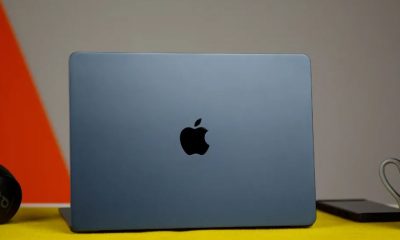Technology
Poco X6 Pro vs Redmi Note 13 Pro Plus
Published
2 months agoon
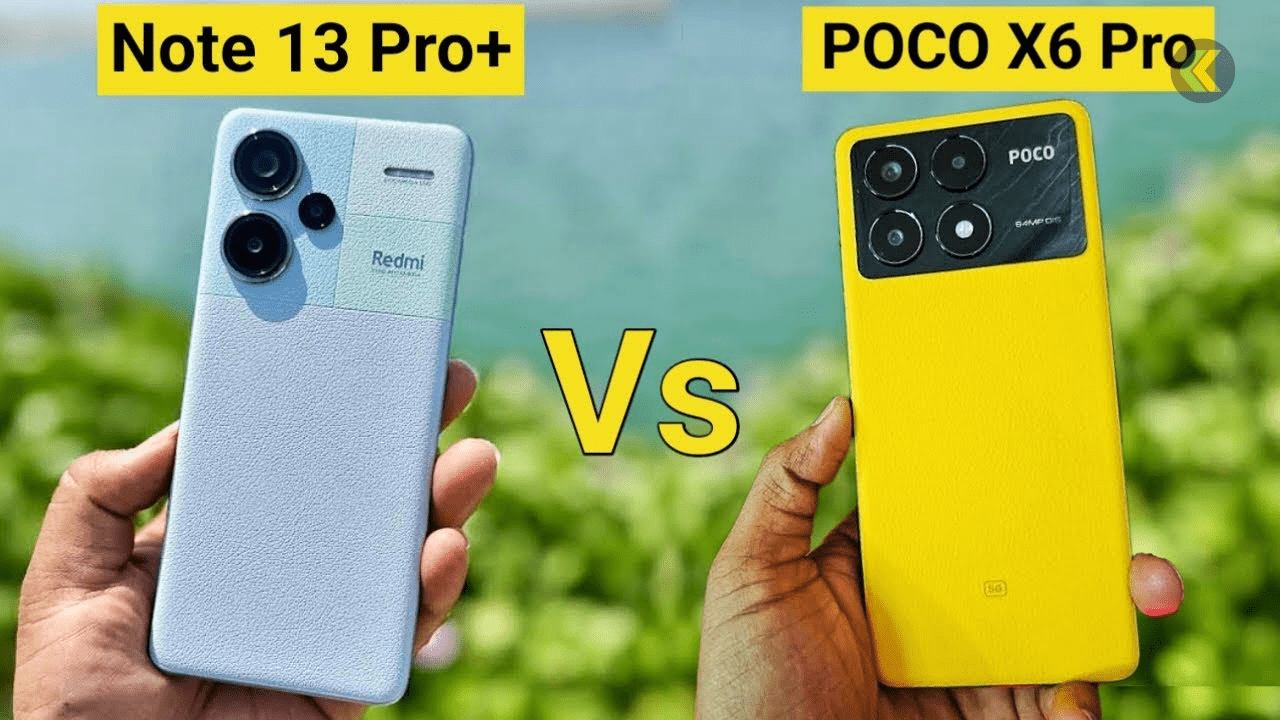

In this article, we will compare Xiaomi’s hottest mid-range phones, Poco X6 Pro vs Redmi Note 13 Pro Plus.
Poco X6 Pro vs Redmi Note 13 Pro Plus
If you have recently visited the mobile market with the intention of buying a mid-range phone, two newcomers have probably caught your attention. These attractive options are Redmi Note 13 Pro Plus and Poco X6 Pro. These two competitors have special and impressive features that can tempt any user. In the following, you are following the comparison of Poco X6 Pro and Redmi Note 13 Pro Plus.
Comparison of Poco X6 Pro and Redmi Note 13 Pro + – technical specifications
| phone name | Poco X6 Pro | Redmi Note 13 Pro Plus |
| Display | 6.67-inch old screen with a resolution of 1220 x 2712 pixels and a variable refresh rate of 120 Hz / maximum brightness of 1800 nits | 6.67-inch old screen with a resolution of 1220 x 2712 pixels and a variable refresh rate of 120 Hz / maximum brightness of 1800 nits |
| chipset | Mediatek Dimensity 8300 Ultra | Mediatek Dimensity 7200 Ultra |
| RAM memory | 8 or 12 GB LPDDR5X | 8, 12 or 16 GB LPDDR5 |
| internal memory | 256 or 512 GB of UFS 4.0 type | 256 or 512 GB of UFS 3.1 type |
| Operating system (at the time of release) | Hyper OS based on Android 14 | Android 13 and MIUI 14 skin |
| Main camera | The trio includes a 64-megapixel wide camera with optical stabilization, an 8-megapixel ultra-wide camera and a 2-megapixel macro. | The trio includes a 200-megapixel wide camera with optical image stabilization, an 8-megapixel ultra-wide camera, and a 2-megapixel macro camera. |
| selfie camera | 16 megapixels | 16 megapixels |
| battery | 5000 mAh | 5000 mAh |
| Charging technology | Wired 67 watts | Wired 120 watts |
| Weight | 186 or 189 grams depending on the body material | 199 or 204.5 grams depending on the body material |
| body | Plastic back frame or artificial leather / plastic frame / protective glass Gorilla Glass 5 for the display / IP54 standard to resist the penetration of dust and water droplets | Glass back frame or artificial leather / Plastic frame / Gorilla Glass Victus protective glass for the display / IP68 standard for resistance to dust and water up to 1.5 meters for half an hour. |
| Price | 512/12 GB model 17 million Tomans | The 8/256 GB model costs about 17.5 million Tomans |
Two attractive mid-range Xiaomi phones, Poco X6 Pro and Redmi Note 13 Pro Plus, have been made available to Digiato by the “Google Kala” online store. Google Kala is considered one of the largest collections of all kinds of smartphones, wearable gadgets, and other electronic devices. To get more information about the product portfolio of Google products, enter the website of this online store.
Design and build quality


Comparing Poco X6 Pro and Redmi Note 13 Pro +, the overall appearance and design language of the two devices are very different from each other; Therefore, first of all, you should see which of these mid-ranges is more suitable for your taste. Poco’s representative uses a body with almost flat edges, which is why the design of this product is closer to the current trend of smartphones. Instead, the Redmi Note 13 Pro Plus takes a completely different approach and has a curved back and front panel.
Mid-range Redmi, despite the older design language, has a more compact appearance and can be more attractive to minimalist fans. Since the back of the Poco X6 Pro has a giant rectangular module, this can make the mid-range Poco a bit difficult to work with.


The weight becomes heavier when you know that the weight and thickness of Poco are a little less compared to its rival. Despite all this, the choice between the design of this phone completely depends on your taste. If you are interested in a screen with curved edges and a more minimal design, the Note 13 Pro Plus is a better option; But if you deal with the giant module of Poco X6 Pro, maybe the more comfortable and updated design of this device will attract you more.
In terms of build quality, the flagship of the Redmi Note 13 series easily defeats its competitors. This phone not only uses a glass back panel, but its display is also protected by Victus Gorilla Glass. But this is not the whole story; Because the mid-range Redmi uses the more advanced IP68 standard to withstand dust and water penetration up to a depth of 1.5 meters and for 30 minutes. All these features have made Redmi Note 13 Pro Plus a more premium option than Poco X6 Pro.
Display


The screens of Poco X6 Pro and Redmi Note 13 Pro Plus are exactly the same. Both devices have a 6.67-inch OLED display with a resolution of 1220 x 2712 pixels and use key features such as a 120 Hz refresh rate, a maximum brightness of 1800 nits, 100% DCI-P3 color gamut coverage, and 68 billion colors. In addition, you can watch high-quality HDR10+ and Dolby Vision videos on these phones.
The screen quality of both mid-range Xiaomi phones is completely different and cannot be distinguished between them. Despite this, the curved edges of the Redmi Note 13 Pro Plus display are somewhat glossier than its competitor, which can make it difficult to watch content under the sun. Despite this, the display quality of Poco X6 Pro and Note 13 Pro Plus is at the level of the best up to 20 million Tomans.
Software and user interface


In this comparison of Poco X6 Pro and Redmi Note 13 Pro Plus, major differences can be seen. Despite the almost simultaneous release of both mid-range phones, Poco X6 Pro has been released with HyperOS operating system based on Android 14 by default. This happened for the first time in the global market so that Poco’s representative is one of the most up-to-date mid-range. In addition, Poco has promised to provide three Android updates to its representative so that we can finally see the release of Android 17 for this attractive mid-range.
Here, the work of Redmi Note 13 Pro Plus becomes very difficult; Because this phone is released with Android 13 and MIUI 14 skin, which is practically one generation behind its competitor. Apart from that, only two major updates are likely to arrive for the flagship Redmi Note series. This means that Redmi Note 13 Pro Plus is two generations ahead of its competitor in terms of software. In the same order, the score of this section goes to Poco X6 Pro. Maybe if Redmi had modified its software support policy like Poco, it could still maintain its attractiveness in this sector.
Hardware performance


This section contains one of the main differences between Poco X6 Pro and Redmi Note 13 Pro Plus. Poco has equipped its mid-range with the powerful Mediatek Dimensity 8300 Ultra chip, which is actually the most powerful chipset in the world of mid-range phones. On the other hand, Redmi Note 13 Pro Plus is powered by the MediaTek Dimensity 7200 Ultra chip. Both chips are made with TSMC’s 4nm lithography and use ARMv9 cores in their CPU; But who will be the winner of this battle? In the following table, we review the comparison of Poco X6 Pro and Redmi Note 13 Pro Plus in the scores obtained from Entuto, Geekbench, PCMark and TriDMark benchmarks:
| phone name | Antutu V10 | GeekBench 6 Single-Core | GeekBench 6 Multi-Core | PCMark Work 3.0 | 3DMark WL Unlimited | 3DMark WLE Unlimited |
| Redmi Note 13 Pro Plus | 738642 | 1127 | 2687 | 12184 | 4506 | 1209 |
| Poco X6 Pro | 1351958 | 1422 | 4398 | 14372 | 11271 | 3039 |
Poco X6 Pro decisively takes its competitor out of the way. This device is almost 2 times more powerful than the Note 13 Pro Plus, and this can be its most important trump card against its half-brother. It goes without saying that the Dimensity 7200 Ultra in the representative of Redmi is still considered a powerful chip and can run most of the games of the day with the highest possible quality. On the other hand, the performance stability of this phone is even higher. Still, the score of this section goes to Poco X6 Pro; Because the processing power of this phone is comparable to the more expensive flagships of the market.
Camera




This time, it is the turn of Redmi Note 13 Pro Plus’ trump card, i.e. the camera. In its new mid-range, Poco paid more attention to hardware performance and instead used simpler cameras. This trend is reversed in Redmi Note 13 Pro Plus, and instead of using a stronger chip, this brand uses a more professional camera to be the best option for photography lovers. First, we review the specifications of the mid-range cameras of Poco and Redmi.
| phone name | Poco X6 Pro | Redmi Note 13 Pro Plus |
| Wide camera | 64 megapixels with optical image stabilization and F1.7 factor | 200 megapixels with optical stabilization and F1.65 factor |
| Ultra wide camera | 8 megapixel with F2.2 factor and 120 degree viewing angle | 8 megapixel with F2.2 factor and 120 degree viewing angle |
| Macro camera | 2 megapixels with F2.4 factor | 2 megapixels with F2.4 factor |
| selfie camera | 16 megapixels with F2.4 factor | 16 megapixels with F2.4 factor |
| Video recording capabilities | Filming with 4K resolution and a rate of 24 or 30 frames per second | Filming with 4K resolution and a rate of 24 or 30 frames per second |
The main strength of Redmi’s representative camera is its 200 megapixel main camera with ISOCELL HP3 sensor, which provides higher quality images, greater clarity and wider color richness. The other cameras of both phones are the same, and both the secondary cameras and the selfie camera of both devices have the same specifications. You will see sample images in the comparison video of Poco X6 Pro and Redmi Note 13 Pro Plus.
Battery and charging




Although these oriental warriors are both powered by a 5000 mAh battery, which ultimately offers a longer battery life? As you probably know, it’s not all about battery capacity. These mid-range newcomers have a very optimized hardware set, and this has improved their charging compared to previous generations. On the other hand, we see significant differences in the software sector; Because Poco X6 Pro has been launched with HyperOS, which is a more optimized version of MIUI. Due to this incident, Poco X6 Pro has better battery charging; But it is expected that the charging capacity of Redmi Note 13 Pro Plus will increase slightly with the release of HyperOS.
It is true that the flagship charging of the Redmi Note series is slightly lower than its competitor; But Redmi has compensated for this issue by offering a more powerful 120-watt charger, so that it can be fully charged in less than 20 minutes. This figure has reached about 45 minutes with the 67-watt charger for the Poco X6 Pro, which is an important difference.
Summing up the comparison of Poco X6 Pro and Redmi Note 13 Pro Plus


Xiaomi’s subsidiaries have set the Iranian and world mobile market on fire by releasing two new mid-range phones. These midranges have attractive specifications and distinctive features so that practically many of their competitors are unable to compete with these products. However, many users are confused in choosing between these two models, i.e. Poco X6 Pro and Redmi Note 13 Pro Plus. If you prioritize hardware performance, handiness of the phone and more up-to-date software, it is better to go for Poco’s new mid-range. Other users who are interested in a better camera, higher build quality and higher resistance to water penetration and faster charging speed can also choose the best Redmi Note series phone.
On the other hand, it is interesting to note that the price of the 8.256 GB model of Redmi Note 13 Pro Plus is almost the same as the 12.512 GB model of the Poco X6 Pro, and this can be another advantage of the mid-range Poco over its half-brother. You can read Redmi Note 13 Pro Plus review and Poco X6 Pro review at elixirofscience.


You may like
Technology
MacBook Air M3 review; Lovely, powerful and economical
Published
6 days agoon
06/05/2024

MacBook Air M3 review; Lovely, powerful and economical
If you are looking for a compact, well-made and high-quality laptop that can be used in daily and light use, the MacBook Air M3 review is not for you; So close the preceding article, visit the Zomit products section and choose one of the stores to buy MacBook Air M1 ; But if you, like me, are excited to read about the developments in the world of hardware and are curious to know about the performance of the M3 chip in the Dell MacBook Air 2024 , then stay with Zoomit.
The design is a copy of the original from the last generation
Almost two years have passed since Apple said goodbye to the familiar and wedge-shaped MacBook Air design; A different design that accompanied this ultrabook from the first day of its birth in 2008; But finally in 2022, with the aim of harmonizing the design language of the Apple laptop family, it was abandoned so that the MacBook Air 2022 will have a similar appearance to the 14-inch and 16-inch MacBook Pro.
The new MacBook Air is uniform in thickness; But it was slimmer, the screen was bigger, the edges were narrower and the corners were rounded, and a relatively large notch was added to it, whose only existence was to host the device’s 1080p webcam. MacBook Air 2022 also marked the return of the MagSafe magnetic charging port to Apple’s popular Ultrabook.
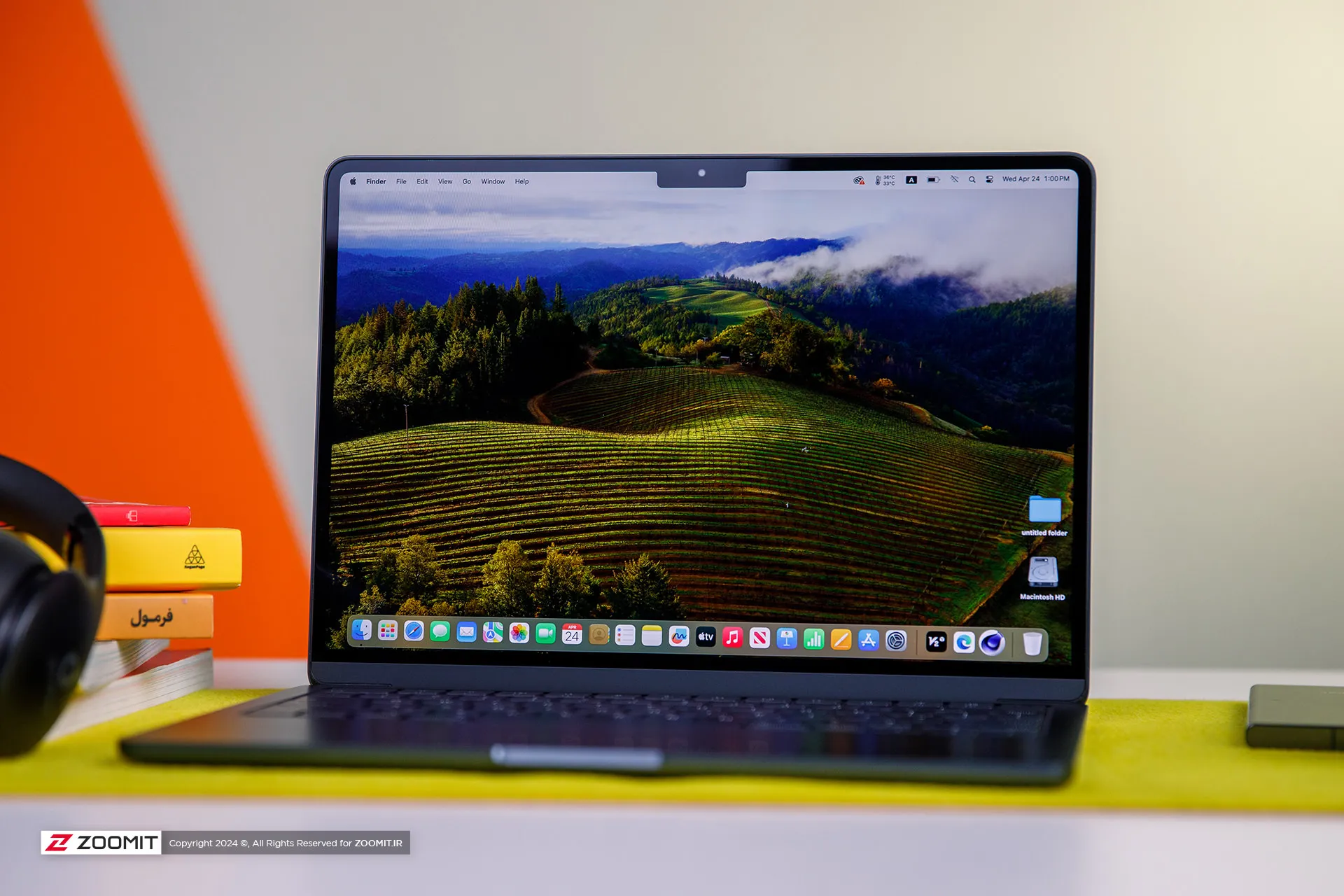
Previously, in the review of the MacBook Air 2022 with the M2 chip, we have talked comprehensively and deeply about its design and its positive and negative points. I suggest that if you haven’t read the article, you must visit it; Because the MacBook Air M3 is no different from the MacBook Air M2 in terms of appearance, display, or ports.
We also see the same incredibly well-made and metal body of MacBook Air 2022 in the new generation of Apple Ultrabooks; A body that, like the rest of Apple laptops, is carved from an aluminum block instead of the usual method of using aluminum sheets, and for this reason, it has a strong and dense structure so that we do not see the body sinking when pressing the keyboard area or the screen frame swinging.



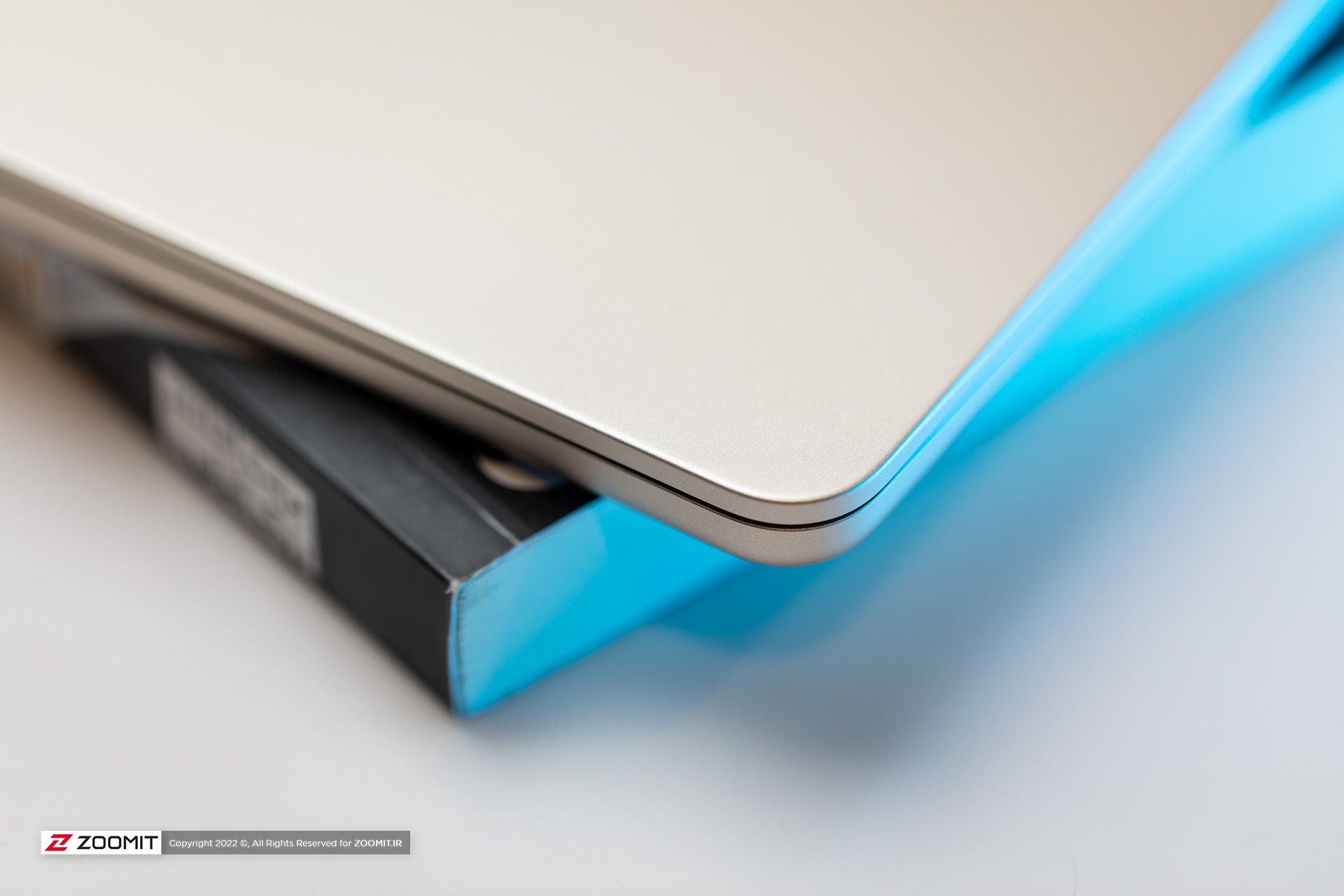
All the parts of the MacBook Air 2024 are assembled with the utmost care; So that there is no gap between them. As expected, the hinge of the laptop is also well-adjusted so that you don’t need to use two hands to open the laptop door. All in all, the combination of the quality of components and Apple’s exemplary engineering precision, brings an extremely enjoyable and unique feeling to the user while using the MacBook Air.
Just like the previous generation, the new MacBook Air is sold in four colors: gray, silver, dark blue, and cream. One of the flaws that could be found in the design of the MacBook Air 2022 was that fingerprints and grease remained on the body; The item that was more noticeable in dark blue color. Apple says this year it has used a new coating that reduces the severity of this problem. We did not have the 2022 model available for comparison at the time of writing the following review, But traces of fat and finger still remain on the body of the MacBook Air 2024.
 Grease and fingerprints on the laptop body
Grease and fingerprints on the laptop body
MacBook Air keyboard is among the best examples in the market in terms of arrangement and dimensions, feedback, and key stability; But the matte coating on the keys absorbs the fat of the fingers very quickly, and on the other hand, like other MacBooks, there is a possibility that the matte coating will disappear and the keys will become shiny. Depending on your usage, this can happen very quickly or over time; For example, for me, who is constantly writing, the keys on my MacBook Pro M1 burned out in less than a year.
Apparently, the buyers of used laptops are very sensitive about the keys being electrocuted; Therefore, if you plan to replace your Macbook with another laptop after one or two years, be sure to keep this in mind and use an external keyboard for long typing.
As always, the trackpad is one of the main strengths of any MacBook, and the MacBook Air M3 follows the same rule. The glass trackpad of the device is large in size and has little friction on its surface, it offers flawless, accurate, and smooth performance, and its Fortouch mechanism, which makes it possible to click on the entire surface of the trackpad, is so efficient that after the MacBook, it is impossible to work with the trackpad of any laptop. Another enjoyed.
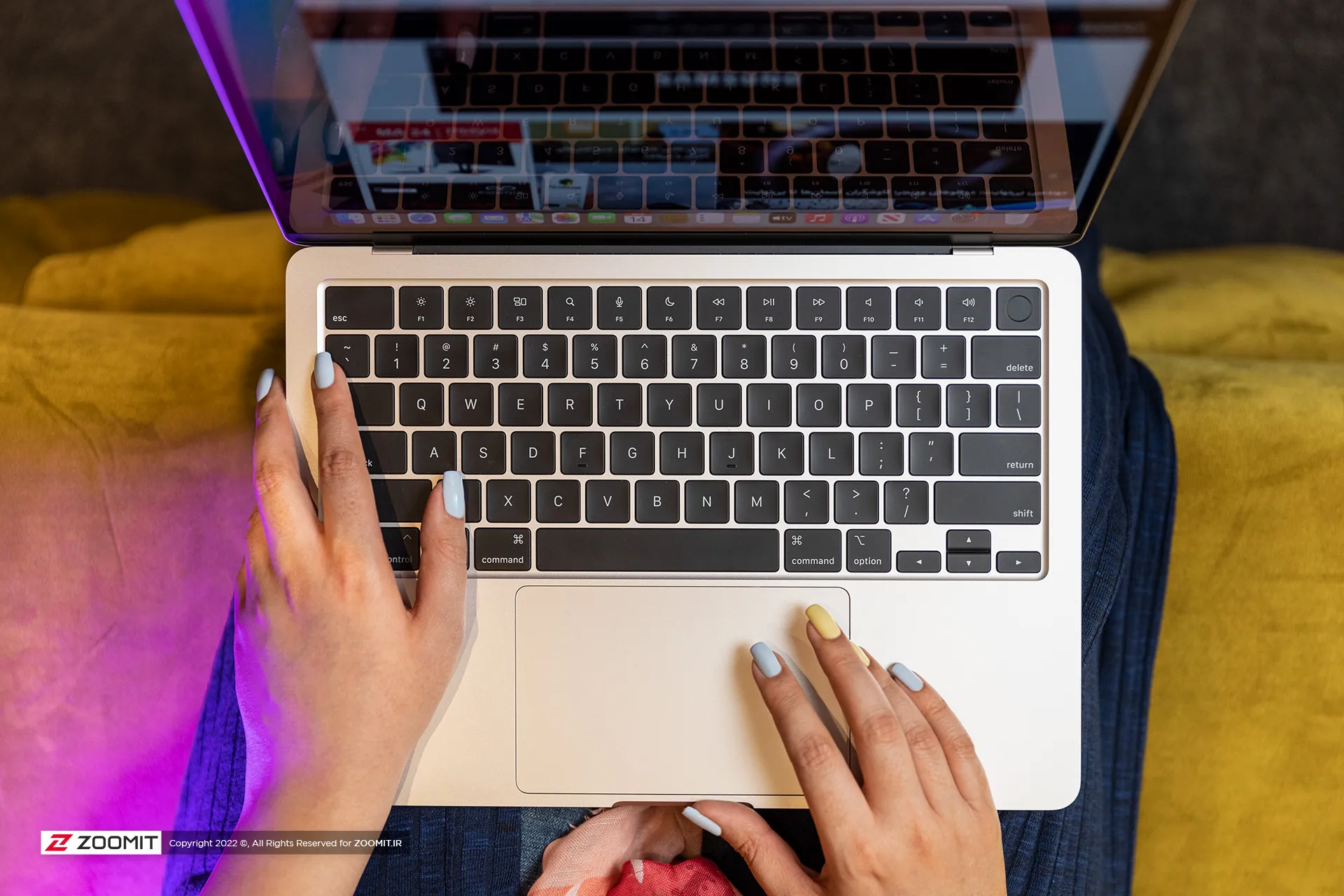 MacBook Air 2022
MacBook Air 2022
The set of MacBook Air 2024 ports is limited and has not changed; On the right side of the device, there is a headphone jack, and the left side of the device hosts two USB4 ports and a MagSafe magnetic charging port. Along with the basic model, Apple provides a relatively small 30-watt adapter with a cloth cable of the same color as the device’s body; But you can also get the laptop with a more powerful 35 or 70-watt adapter, which charges the battery up to 50% within half an hour.
USB4 ports support Thunderbolt 3 standard with a bandwidth of 40 Gbps, But it is not possible to connect external graphics. Both ports also transmit the image signal with the DisplayPort standard. In the new MacBook, if you close the laptop door, you can connect a 6K monitor and a 5K monitor (both 60Hz) to the device at the same time; But with the laptop’s screen on, just like the MacBook Air M2, the image output is limited to a 6K monitor; It is interesting that the Intel version of MacBook Air could output images to two 4K monitors at the same time as its own screen is on!
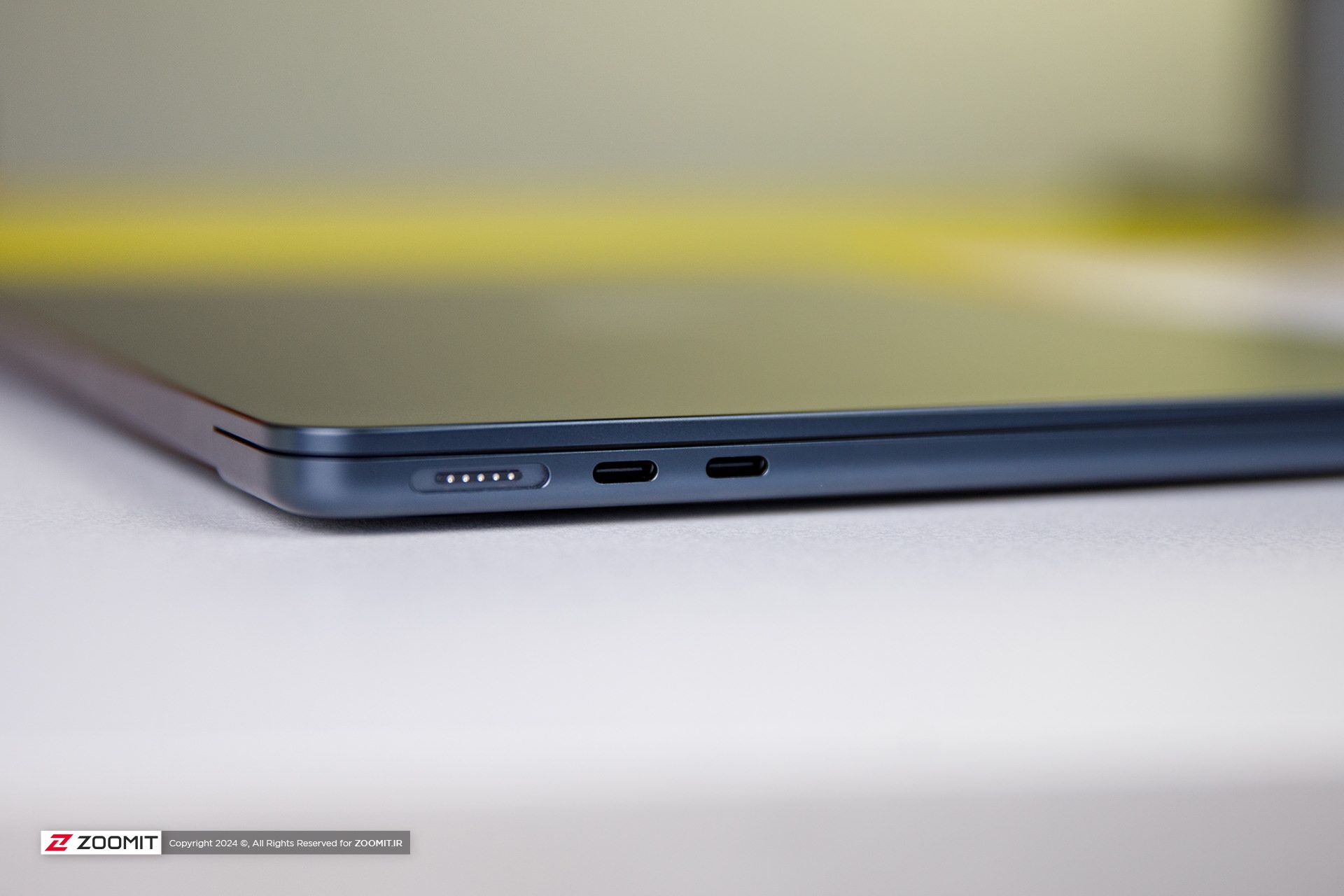
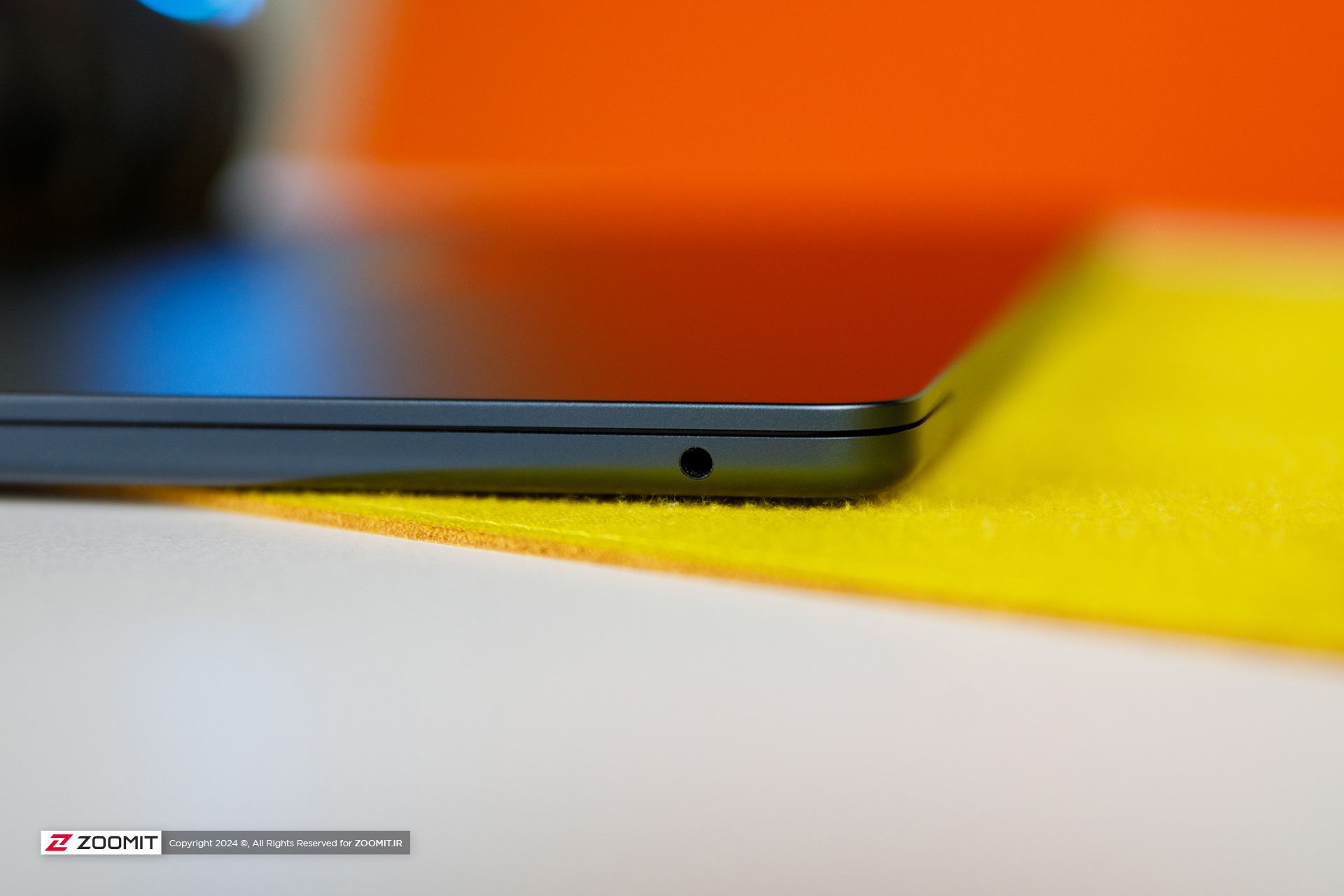
As in the previous generation, Apple uses Bluetooth version 5.3 in its Ultrabook; But the Wi-Fi module has upgraded the device from Wi-Fi 6 to Wi-Fi 6E, which incompatible networks can increase the communication bandwidth of MacBook Air 2024 with the router and the rest of the devices in the network from 1.2 to 2.4 Gbps.
Attractive display with more attractive competitors
Like most parts of the device, the screen of the new MacBook Air does not change; Of course, in this field, you can’t criticize Apple much, since 2018, when the MacBook Air screen became Retina, it has always been among the best; However, today, with OLED competitors with stunning colors and infinite contrast, Apple’s Retina display no longer has its former glory.
MacBook Air M3 can be purchased just like the previous generation in two 13.6-inch and 15.3-inch models. The pixel density of both versions is a very good number of 224 pixels. With this density, the MacBook Air screen produces a very clear image. So that it is difficult to distinguish the pixels from each other. We have the 13.6-inch MacBook Air M3 with a resolution of 2560 x 1664 pixels available for review.

Unfortunately, unlike the expensive models of MacBook Pro or even Windows Ultrabooks with the same price as Zenbook, the panel of the MacBook Air is 60 Hz and it does not have amazing technologies such as OLED and MiniLED to produce 1000 nits of brightness and extraordinary colors. MacBook Air uses an 8-bit IPS LCD panel with back exposure, which, by using FRC technology, can give the user the feeling of 10-bit panels with a billion colors.
MacBook Air covers the wide DCI P3 color space with high accuracy. The Apple Ultrabook covers 98.4% of this space with an error of 1.9 (an error of less than 3 is ideal), perhaps the only color weakness of the panel can be considered a slight tendency to be cold; However, thanks to the True Tone feature, the device evaluates the ambient light temperature with high accuracy and adjusts the color temperature accordingly to give you a satisfying visual experience.
In our measurements, with a 50% raster standard, we reached a maximum brightness of 443 nits, which in itself is a very good number, and thanks to the anti-reflective coating on the panel surface, in environments with different light conditions, it brings a satisfactory experience of working with a laptop. Without the appearance of the shadow of the environment on the panel, the user will not be bothered.
|
MacBook Air 2024 screen performance against other laptops |
||||||||||
|---|---|---|---|---|---|---|---|---|---|---|
|
Laptop / test |
White image |
Black image |
contrast ratio |
AdobeRGB |
sRGB |
DCI-P3 |
||||
|
Maximum brightness |
Minimum brightness |
Average brightness |
Native |
cover |
Average error |
cover |
Average error |
cover |
Average error |
|
|
MacBook Air 2024 |
443 intentions |
0.00 nits |
0.67 nits |
661 |
87.9 |
— |
100 |
2.4 |
98.4 |
1.9 |
|
Zenbook 14 |
512 intention (788 nits HDR) |
0.27 nits |
0 intentions |
∞ |
89.6 |
2.6 |
100 |
0.6 |
99.7 |
1.3 |
|
MacBook Pro 2022 |
437 intentions |
0.00 nits |
0.5 nits |
874 |
86.3 |
— |
99.8 |
2.7 |
97.5 |
— |
|
MacBook Air 2022 |
447 intentions |
0.1 nit |
0.65 nits |
693 |
87.5 |
— |
100 |
2.5 |
98.1 |
— |
|
Galaxy Book 3 Ultra |
441 intentions |
4 intentions |
0 intentions |
∞ |
97.3 |
3.7 |
99.6 |
1.9 |
99.8 |
2.3 |
|
MacBook Pro M1 Max |
455 intentions (1497 nits HDR) |
0 intentions |
0 intentions |
∞ |
85 |
— |
121.6 |
— |
97.3 |
2.5 |
In addition to the reasonable maximum brightness of 442 nits in bright images, unlike most laptops with IPS LCD screens, the black color brightness is also very low in the MacBook Air display; So that the device achieves a very high contrast. On the other hand, the minimum brightness of the display was 0 nits even with the 0.01 nits accuracy of the Zoomit luminance meter; In the sense that while using the laptop, there will be a little pressure on your eyes.
The attractive screen of the MacBook Air is completed by a set of 4 speakers; Speakers that have a very large sound volume compared to the size of a laptop, produce clear sound, and at high volumes, they are confused and distorted. MacBook Air speakers support Dolby Atmos and are easily ahead of most Windows laptops.
M3 chip and championship called TSMC
The main changes of MacBook Air 2024 have happened in its heart; Where it hosts the M3 chip as the beating heart of the device. Next, before we put the performance of the M3 under the microscope, we take a look at the details of the technical specifications of this chip.
The M3 chip is manufactured using TSMC’s 3nm-based manufacturing process known as N3B, hosts 25 billion transistors on its surface, and uses the same layout and configuration as the M2 for the CPU and GPU cores. Apple says the processor and graphics used in the M3 are about 35 and 65 percent faster than the M1, respectively.
|
Technical specifications of M3 against M2 and M1 |
|||
|---|---|---|---|
|
parameters/chip |
Apple M3 |
Apple M2 |
Apple M1 |
|
manufacturing process |
3 nanometer N3B TSMC |
TSMC’s second-generation 5nm |
5 nm N5 TSMC |
|
CPU |
4 powerful cores with a maximum frequency of 4.05 GHz 4 low-power cores with a maximum frequency of 2.75 GHz |
4 Avalanche cores with a maximum frequency of 3.5 GHz 4 Blizzard cores with a maximum frequency of 2.4 GHz |
4 Firestorm cores with a maximum frequency of 3.2 GHz 4 Icestorm cores with a maximum frequency of 2.0 GHz |
|
cache memory |
16 MB shared L2 cache and 320 KB L1 cache for each of the powerful cores 4 megabytes of shared L2 cache and 192 kilobytes of L1 cache for each low-power core 8 MB system cache for the entire chip |
16 MB shared L2 cache and 320 KB L1 cache for each of the powerful cores 4 megabytes of shared L2 cache and 192 kilobytes of L1 cache for each low-power core 8 MB system cache for the entire chip |
12MB shared L2 cache and 320KB L1 cache for each Firestorm core 4 MB shared L2 cache and 192 KB L1 cache for each Icestorm core 8 MB system cache for the entire chip |
|
memory bass |
128 bits |
128 bits |
128 bits |
|
DRAM |
8 to 24 GB LPDDR5-6400 |
8 to 24 GB LPDDR5-6400 |
8 or 16 GB LPDDR4x-4266 |
|
Memory bandwidth |
100 GB per second |
100 GB per second |
68.2 gigabytes per second |
|
GPU |
8 or 10 cores with hardware support of ray tracing |
8 or 10 cores |
7 or 8 cores |
Like the last two generations, the M3 chip uses a combination of 4 high-power cores and 4 low-power cores, respectively, with maximum frequencies of 4.05 and 2.75 GHz as CPU. Apple has made minor changes in the architecture of the cores, and the main difference of the cores is the 15% increase in frequency compared to the M2 cores.
Apple has not even changed the amount of cache memory of the M3 chip compared to the M2; Each of the high-power and low-power cores have access to 320 and 192 KB of ultra-fast L1 cache, respectively, the set of four high-power and low-power cores also have access to 16 and 4 MB of L2 cache, respectively, while the system cache is 8 MB for the set of chip processing blocks. GPU and CPU are included.
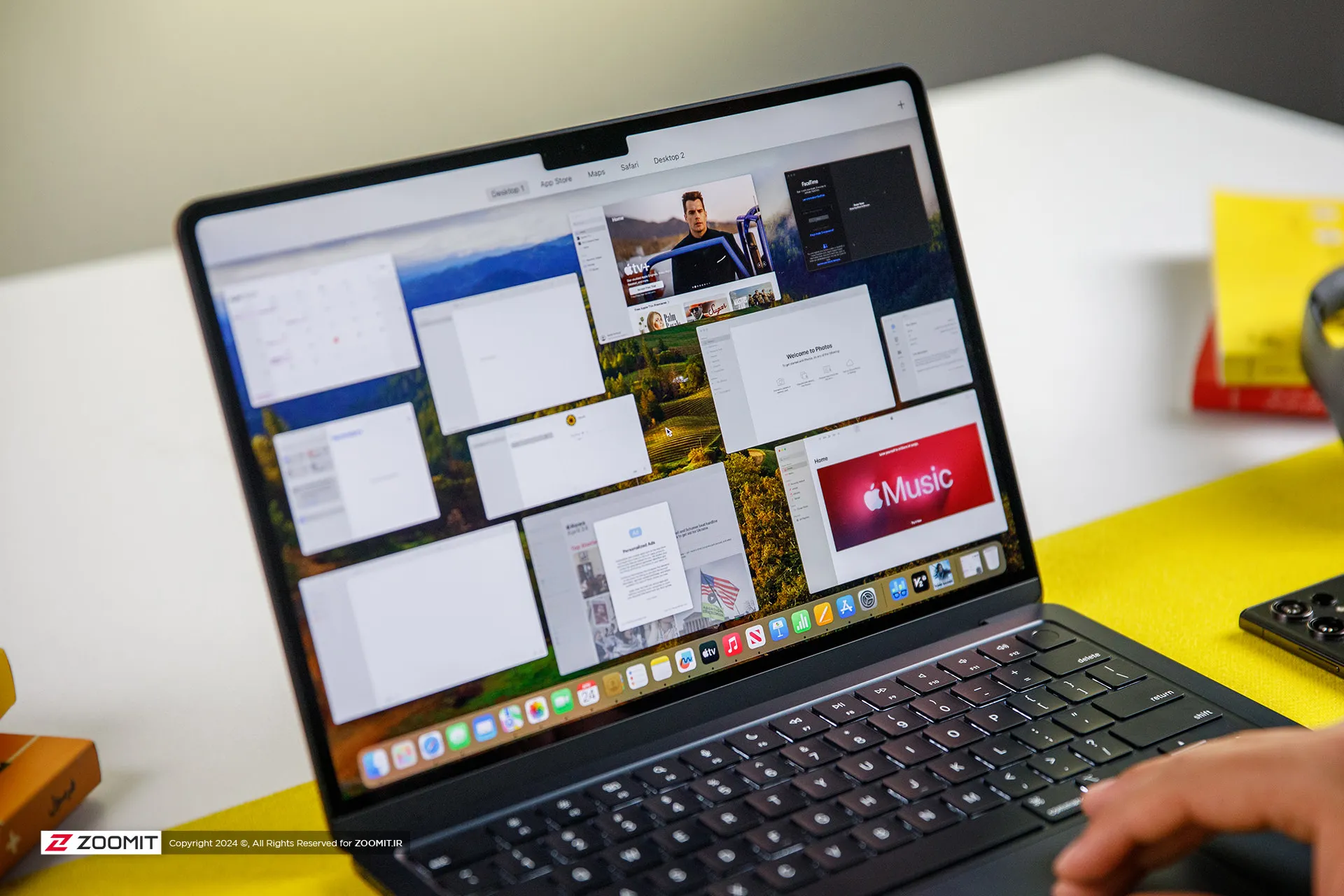
The M3 chip is used in Apple laptops in two versions with 8- and 10-core graphics processors. We had the MacBook Air with 8-core graphics available for review, which in total, just like the last generation, has 128 execution units with 1024 calculation and logic units in its heart, which operate at an almost identical frequency of 1.38 GHz.
The main difference between the M3 graphics compared to the previous generation is the addition of the Ray Tracing hardware accelerator, Mesh shading, and Dynamic Caching technology, the latter of which allows the chip to provide the memory required by the GPU in real-time and based on the type of processing. Thus, it optimizes the amount of memory consumption.
The M3 chip uses a 16-core neural processing unit (NPU) with a computing power of 18 trillion operations per second, and in addition to ProRes and ProRes Raw videos, it now has a separate engine for AV1 video codec decoding. Due to its two 64-bit channels and support for LPDDR5X-6400 RAM, this chip can achieve a bandwidth of 102 GB/s for data exchange with its integrated RAM.
|
Performance of the MacBook Air M3 in benchmarks while plugged in |
||||||
|---|---|---|---|---|---|---|
|
Laptop/benchmark |
Technical Specifications |
Web browsing |
Performance in graphics |
CPU performance in rendering |
CPU computing power |
GPU computing power |
|
3 Dark |
CineBench R23 |
GeekBench 6 |
GeekBench 6 |
|||
|
Speedometer 2.1 |
TimeSpy |
Single Multi |
Single Multi |
OpenCL Metal/Vulkan |
||
|
DirectX 12 |
||||||
|
MacBook Air 2024 |
Apple M3 8 core GPU |
680 |
— |
1897 9872 |
3143 2008 |
25845 41671 |
|
Zenbook 14 |
Core Ultra 7 155H Intel Arc GPU |
396 |
3453 |
1637 13367 |
2290 12256 |
34889 38268 |
|
MacBook Pro 2022 |
Apple M2 10-core GPU |
407 |
— |
1579 8730 |
2581 9641 |
28852 42673 |
|
MacBook Air 2022 |
Apple M2 8 core GPU |
405 |
— |
1577 8476 |
2578 9655 |
27846 39735 |
|
MacBook Pro 2020 |
Apple M1 8 core GPU |
209 |
— |
1512 7778 |
2335 8315 |
21646 32743 |
|
MacBook Pro 14-inch 2021 |
M1 Max 24Core GPU |
300 |
— |
1549 12508 |
2378 12239 |
65432 101045 |
MacBook M3 appears about 20-25% faster than M2 in single-core and multi-core benchmarks, and in comparison with M1, it increases its superiority to about 35-45%; Therefore, considering the 15% increase in frequency and the improvement of TSMC’s manufacturing process, it seems that Apple has not changed much in the architecture; But in any case, CPU performance on par with the M1 Pro is a surprising result for the M3.
Compared to the new Asus ultrabook with the Core Ultra 7 155H chip, MacBook Air M3 leads by 15-35% in single-core benchmarks; But in multi-core benchmarks, it loses the field to the competitor with a single-digit difference of up to 25%. We will talk more about the difference between the two chips in productivity and power consumption.
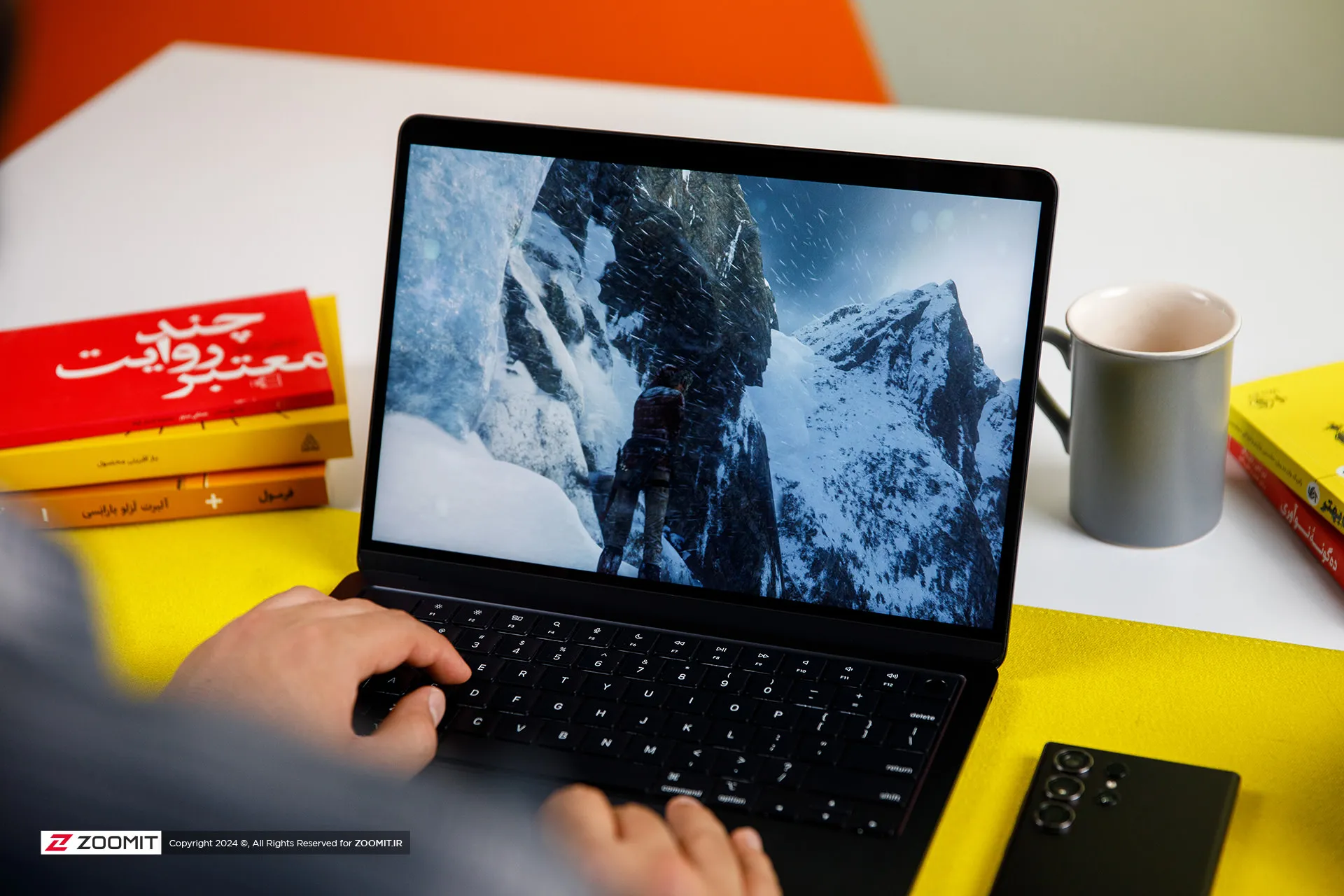
Apple laptops have a stunning performance in terms of web surfing experience and M3 has taken this performance to a whole new level; MacBook Air 2024 outperforms Asus Ultrabook 2024 with a 65% difference in the Zoomit web browsing test. The stunning superiority of the MacBook Air shows that Apple’s laptop offers faster and smoother performance on the web.
Apple’s new ultrabook appears in almost the same level of computing processing as the last generation. It seems that M3 remains behind its Intel competitor by 25% in the processes that take place on the basis of the OpenCL framework; But instead, thanks to Apple’s exclusive Metal framework, it surpasses the performance of Core Ultra 7 in processes based on Vulkan, with a difference of 10%.
Let’s skip the benchmarks and talk about how the MacBook Air 2024 performs in professional software and games. For this, we considered Photoshop and Premiere Pro software, Python code execution, and the Rise of the Tomb Raider game.
The set of games available for macOS is much more limited than for Windows; However, thanks to the tool that Apple introduced at WWDC 2023 for porting Windows games (Game Porting Toolkit), some were able to run titles such as Medium and Cyberpunk 2077 on Macs with powerful graphics processors such as the M2 Max, and it is hoped that in the future, this same tool, pave the way for more games to be released.
We were able to run the old game Rise of the Tomb Raider at 1200p resolution, High graphics settings and an average frame rate of 50.5 fps, which shows an advantage of about 25 percent of the M3 compared to the M2.
 MacBook Air M3 performance while playing Rise of the Tomb Raider game
MacBook Air M3 performance while playing Rise of the Tomb Raider game
MacBook Air M3 works about 10 to 20 percent faster than its two previous generations and ZenBook 14 while using Photoshop software for tasks such as resizing large photos and implementing the blur effect or lens correction.
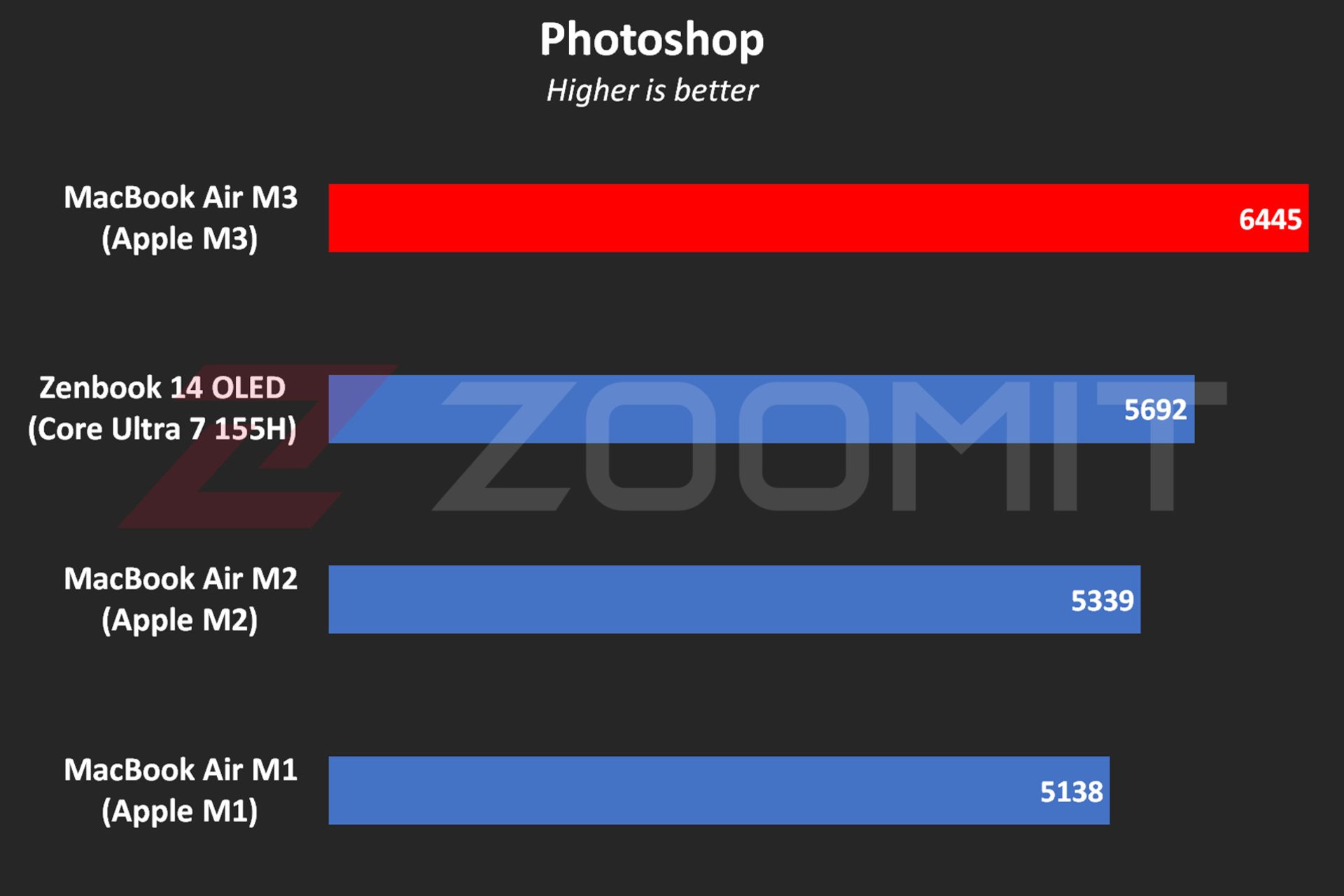 MacBook Air M3 performance in Photoshop software
MacBook Air M3 performance in Photoshop software
In Premier Pro software, while performing tasks such as blur effect implementation, image sharpening, or 4K video output, the performance of the device is 20-30% better than the MacBook Air M2 and Zenbook 14.
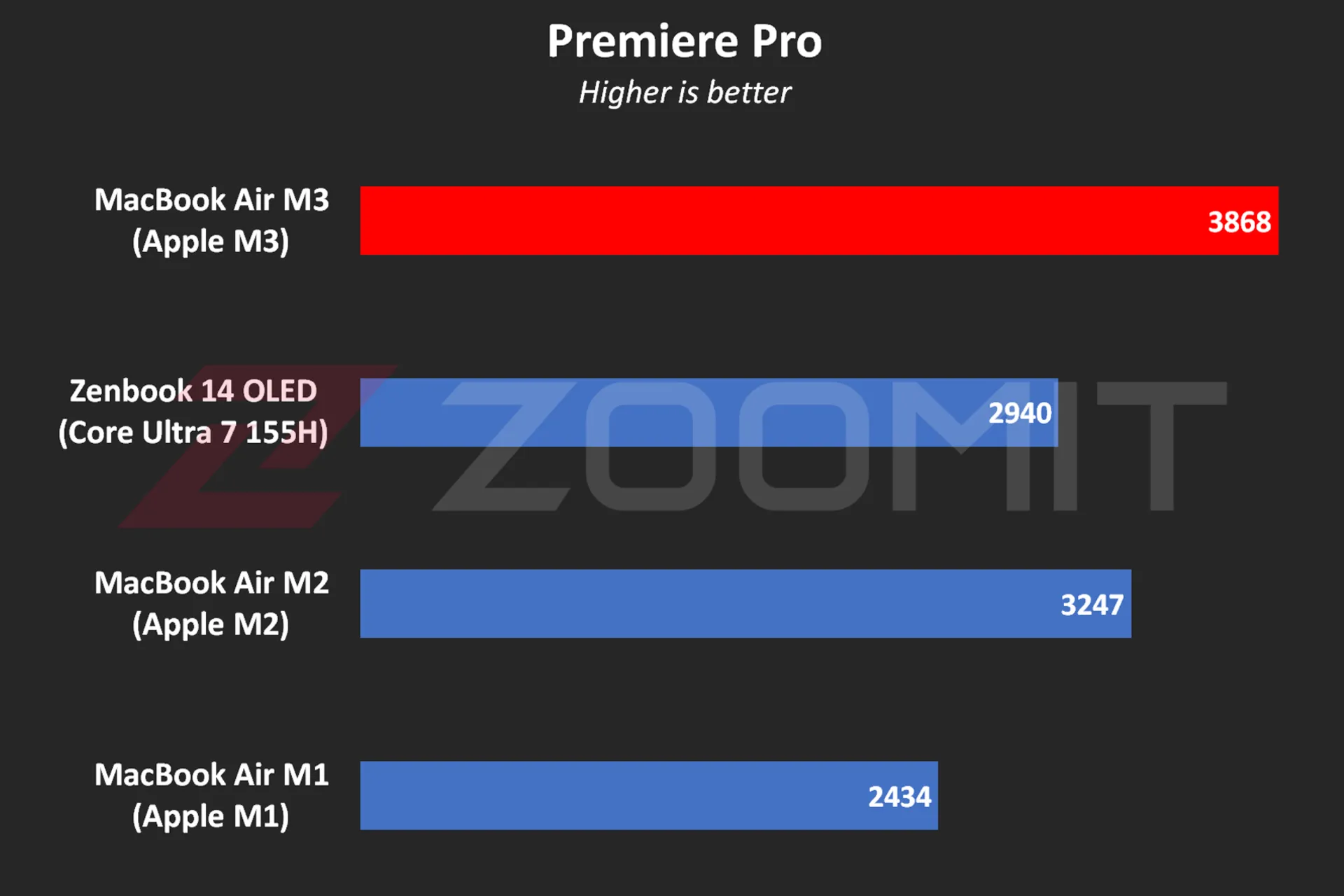 Performance of MacBook Air M3 in Premier Pro software
Performance of MacBook Air M3 in Premier Pro software
Note that in software such as Premiere Pro, where we are dealing with heavy projects, the low RAM overshadows the performance level and you may even get stuck in scenarios like editing 4K videos. Next, we will talk about the MacBook Air M3 RAM.
The MacBook Air was able to run Zoomit’s Python code in about 45 seconds, which is about 13 seconds faster than the M2 and 33 percent faster than the M1.
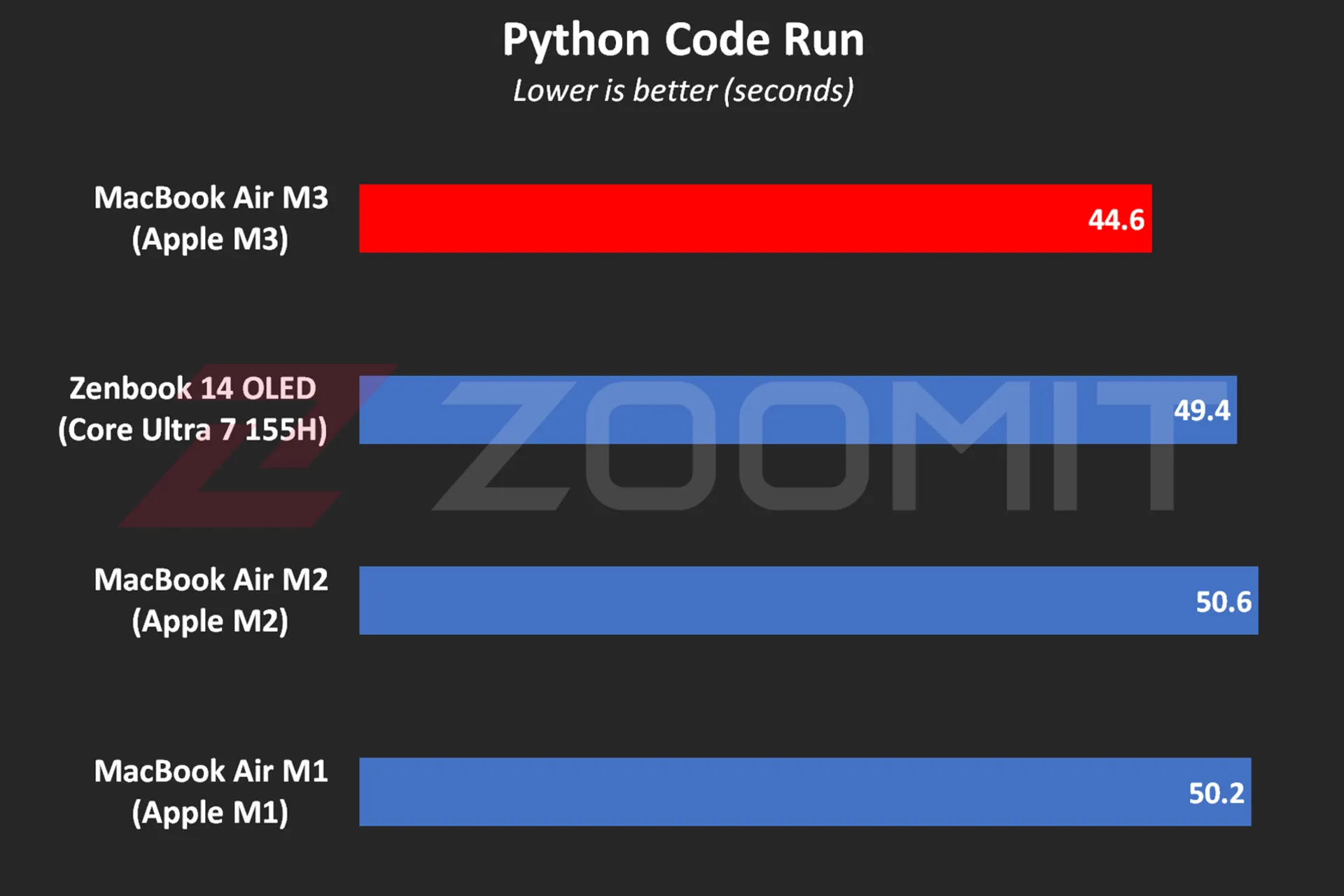 MacBook Air M3 performance while running Python code
MacBook Air M3 performance while running Python code
One of the most attractive features of MacBooks is that they work equally well, whether connected to electricity or relying on batteries; For example, when running Python code while plugged in, the MacBook Air M3 beats the ZenBook 14 by just 4 seconds; But by disconnecting the laptops from the electricity and Zenbook’s performance drop, the time difference reaches 11 seconds!
In addition to running Python code, the MacBook Air also displays similar performance in other software in both plugged-in and battery-powered states; In the table below, you can see the difference in performance of MacBook Air M3 in Plugged and UnPlugged modes in a number of users:
|
Performance of MacBook Air 2024 when connected to electricity and with battery |
||
|---|---|---|
|
Test/Performance |
Plugged result |
Result UnPlugged |
|
CineBench 2024 (MultiCore) |
574 |
573 |
|
Speedometer 2.1 |
680 |
681 |
|
Photoshop |
6488 |
6588 |
|
Premiere Pro |
3868 |
3881 |
|
Python |
44.6 seconds |
44.7 seconds |
In the MacBook Air 2022 review, we said that the lack of an active cooling system (fan) makes this ultrabook unable to provide stable performance under continuous processing loads. Now it’s time for MacBook Air 2024 with the same cooling system; But this time with a more optimized chip, it will be wider. Does the MacBook Air M3 offer stable performance?
To evaluate the cooling system, the performance stability level and measure the power consumption and other parameters of the MacBook Air M3, we first ran the CineBench R23 multi-core test on the device for 30 minutes consecutively in both power-connected and battery-based modes; Then we went to the 20-minute Wild Life Extreme test.
|
MacBook Air 2024 laptop performance under continuous processing load |
||||
|---|---|---|---|---|
|
Laptop status |
CPU score at first |
CPU score after 30 minutes |
GPU score first |
GPU score after 20 minutes |
|
Connected to electricity |
9872 |
7841 |
6989 |
5207 |
|
with battery |
9833 |
8322 |
6996 |
5271 |
MacBook Air M3 shows more or less the same behavior whether in Plugged or UnPlugged mode; After 30 minutes, the CPU performance drops by about 15-20%, and in a 20-minute graphics processing load, the GPU drops by 25%.
Contrary to the numbers stated in the technical specifications of the M3 chip, the MacBook Air 2024, whether in multi-core or single-core processing, never reaches the frequency of 4.05 GHz in powerful cores; In my measurements, the frequency of the most powerful cores in the multi-core test remained at 3.7 GHz for a few seconds; But it immediately begins the gradual process of decline and reaches below 2.5 GHz from the 10th minute, which is lower than the stable 2.75 GHz frequency of low-power cores!
Read more: Asus Zenbook 14 OLED laptop review
 CPU frequency in MacBook Air M3
CPU frequency in MacBook Air M3
The frequency drop process starts when the temperature of the hottest point of the chip reaches 103 degrees Celsius; It seems that Apple has adopted a more conservative strategy this year; Because in MacBook Air M2, the maximum temperature of the chip reaches 109 degrees Celsius. The temperature of 103 degrees of the chip continues for 5-6 minutes and then, thanks to the frequency drop, it decreases to the range below 90 degrees Celsius.
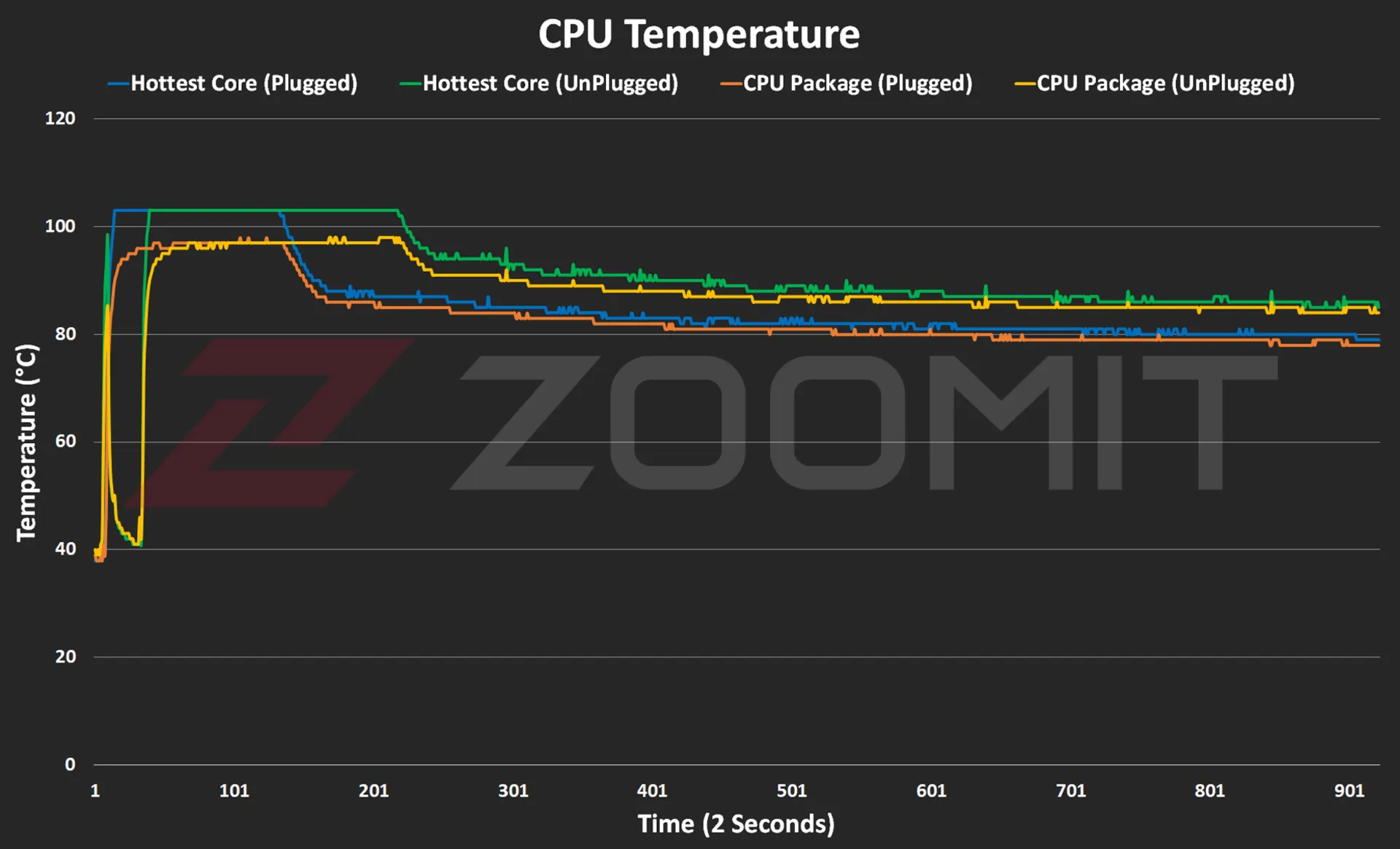 CPU temperature on MacBook Air M3
CPU temperature on MacBook Air M3
The temperature of the laptop body rises to 46-47 degrees Celsius, especially in the upper area of the keyboard; But in general, the body heat is not such that you cannot continue working with the laptop.
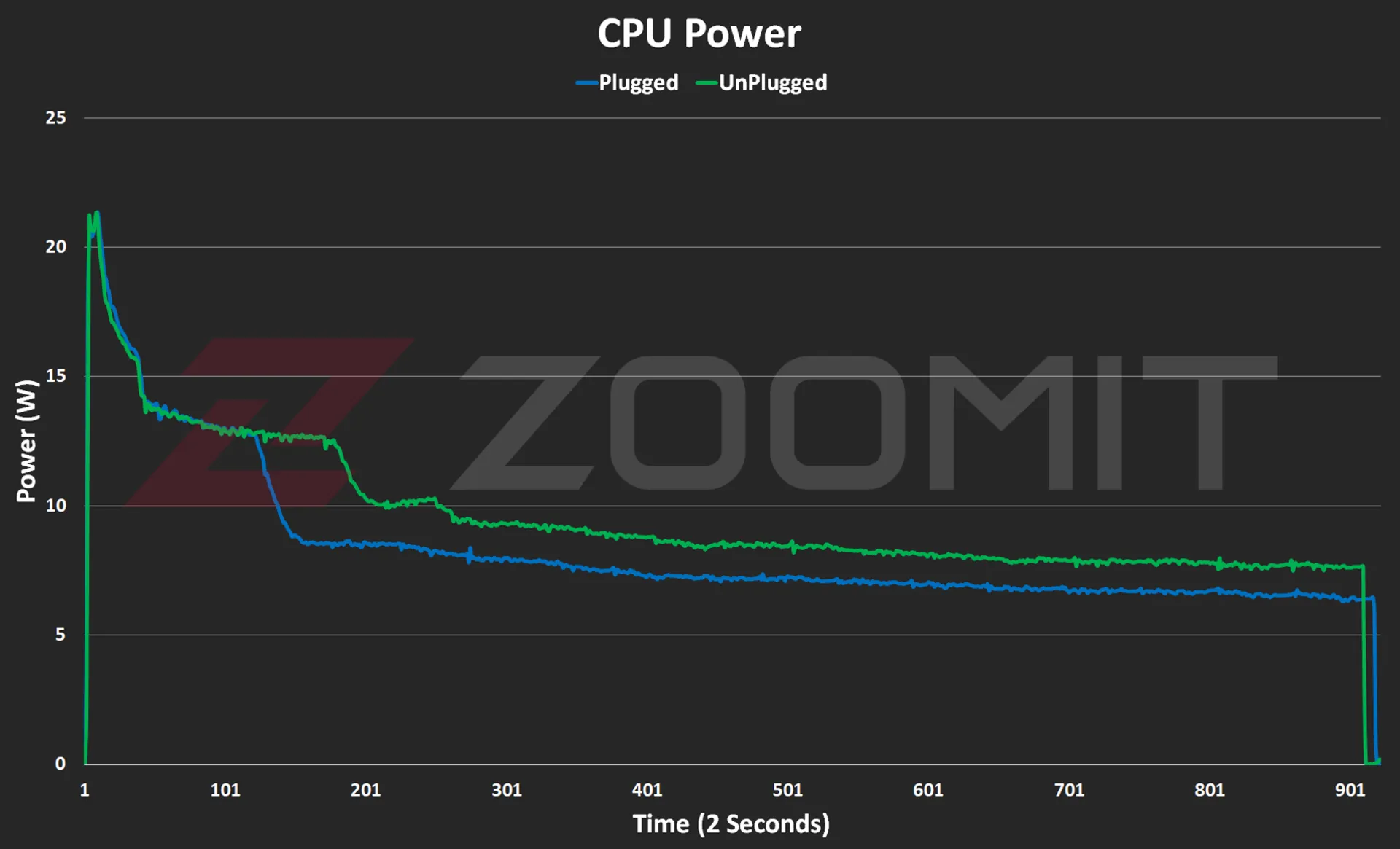 CPU consumption in MacBook Air M3
CPU consumption in MacBook Air M3
As you can see in the power consumption graph, the CPU consumes about 21 watts in the first few seconds; But as the body heats up, the power consumption gradually decreases and after a few minutes it reaches below 10 watts and reaches the range of 7-8 watts.
As you can see from the graphs below, the M3 GPU also follows a similar path to performance degradation from overheating the device.
 GPU consumption in MacBook Air M3
GPU consumption in MacBook Air M3
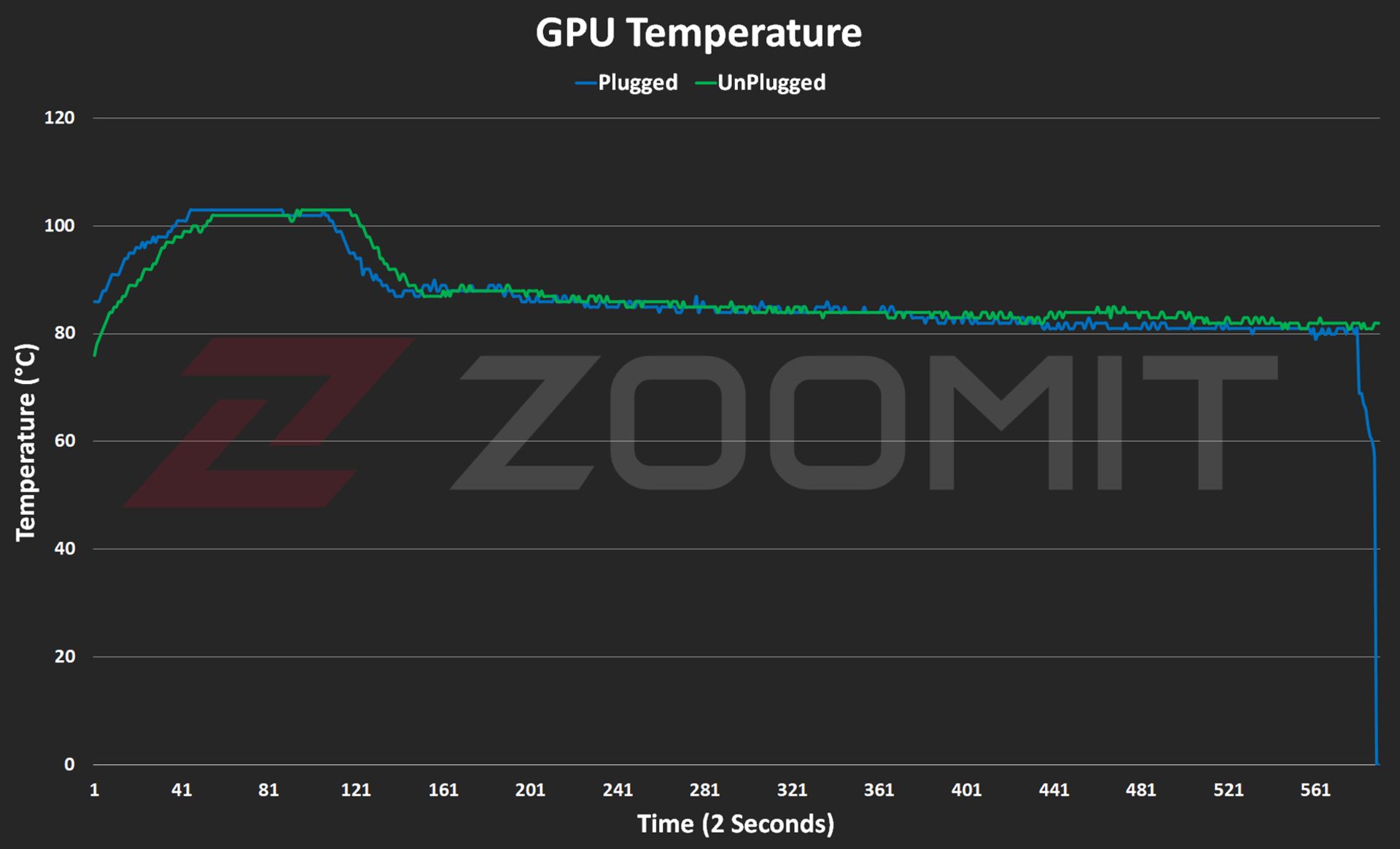
GPU temperature on MacBook Air M3

GPU frequency on MacBook Air M3
About 2-3 minutes after the start of graphic processing, in order to prevent the chip temperature from exceeding 103 degrees Celsius, the frequency of the GPU drops from about 1350 MHz and its power consumption from about 14 watts to 1000 MHz and below 8 watts. is approaching
My tests show that the MacBook Air M3 uses its powerful core stably with a frequency of about 3,750 MHz in single-core processing, this number is about 3,200 and 2,980 MHz in the MacBook Air M2 and MacBook Air M1 laptops, respectively.

In order to have a general outline and limits of architecture changes and IPC (the number of instructions executed per processing cycle), we can divide GeekBench’s single-core score by the chips’ single-core frequency; Note that this measure is not exact and only provides a general picture of the state of architectural changes. To accurately measure IPC, one should go to an expensive tool such as SPECView, which unfortunately is not available in Iran.
 Ratio of performance to CPU frequency
Ratio of performance to CPU frequency
To be more precise, what you see in the graph above is the ratio of single-core performance to CPU frequency in three generations of MacBook Air laptops with M1, M2, and M3 chips. In this chart, I have considered the MacBook Air M1 as a benchmark so that we can compare the other two chips relatively. The numbers say that the architectural changes in M3 have a 4 and 7 percent impact on the performance of this chip compared to M2 and M1, which is not a significant improvement.
In the graph below, you can see the ratio of M3’s performance to its power consumption compared to previous generations and the Core Ultra 7 155H chip. Note that the amount of power consumed by the chips is not stable and after a few seconds, it deviates from its maximum value; Therefore, the graph below was created by running CineBench R23 once and based on the average power consumption during the benchmark execution period, so that we can obtain the ratio of performance to power consumption in the best performance condition of the laptop.
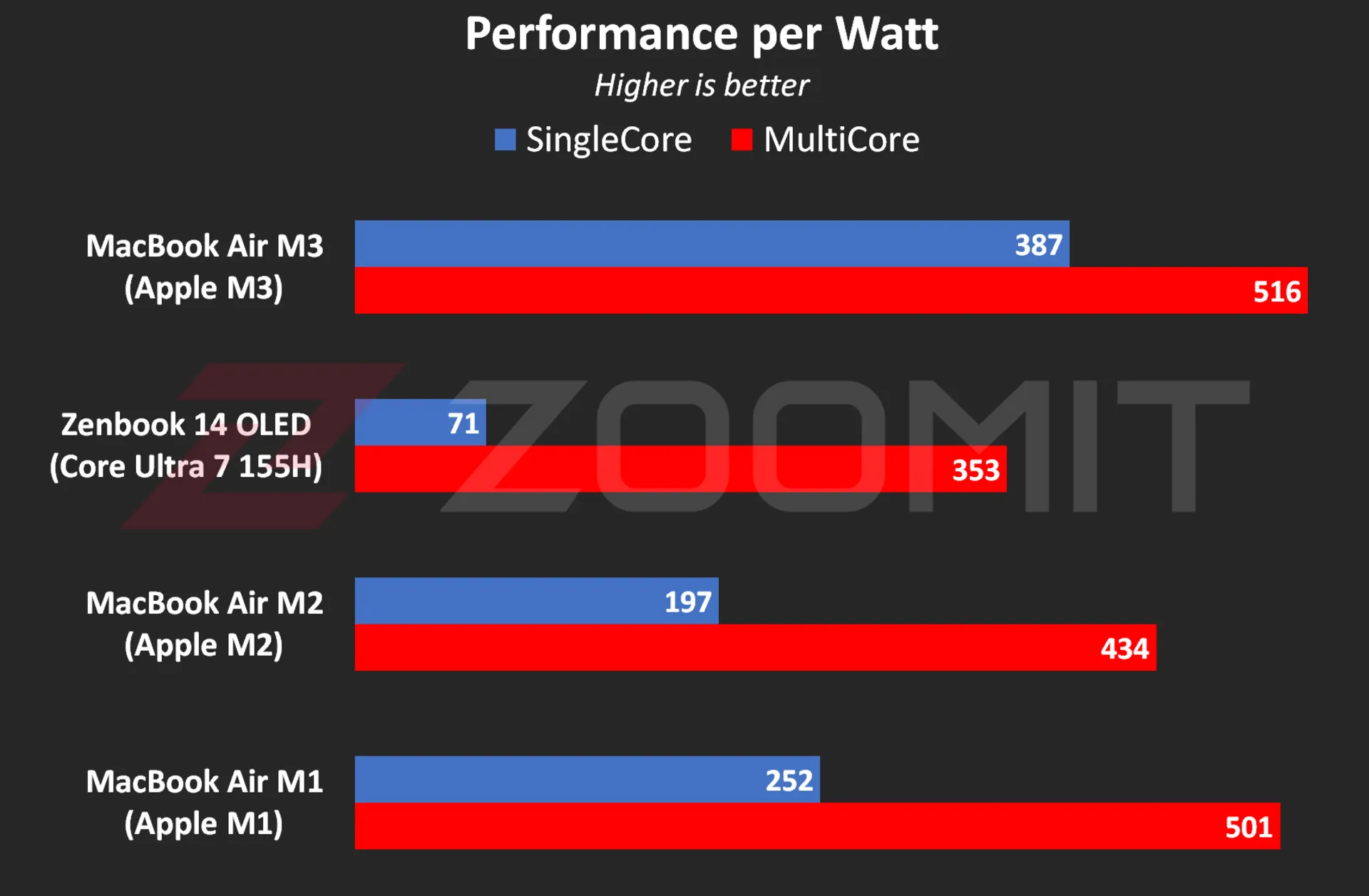 The ratio of performance to CPU power consumption
The ratio of performance to CPU power consumption
My measurements show that the M3 consumes an average of 4.9 and 19.1 watts when running the CineBench R23 single-core and multi-core benchmarks, respectively; While these numbers are equal to 8 and 20.2 watts for the M2 and 23 and 37.8 watts for the Core Ultra 7 155H, respectively, this shows the stunning efficiency of the M3; But if you consider the numbers obtained in the previous chart, you will realize that TSMC’s optimized manufacturing process has more influence on this amazing productivity than IPC and Apple’s architecture improvements.
The M3’s incredible efficiency also contributes to the MacBook Air M3’s excellent charging performance. Apple uses the same 52.6-watt-hour battery as the MacBook Air M2 in its new ultrabook and says that this laptop can charge for about 18 hours, just like the previous generation.
|
MacBook Air 2024 battery life compared to other laptops |
||||||
|---|---|---|---|---|---|---|
|
Laptop/Test |
Functional profile |
hardware |
Display |
Battery capacity |
Play offline video |
Everyday use |
|
Processor and graphics |
Dimensions, resolution, and refresh rate |
watt-hours |
720p Video |
PCMark 10 |
||
|
minute: hour |
minute: hour |
|||||
|
MacBook Air 2024 |
— |
Apple M3 8 core GPU |
13.6 inches and 60 Hz 1664 x 2560 pixels |
52.6 |
14:13 |
— |
|
Zenbook 14 |
Performance |
Core Ultra 7-155H Intel Arc |
14 inches and 120 Hz 1800 x 2880 pixels |
75 |
17:25 |
9:09 |
|
Galaxy Book 3 Ultra |
Performance |
Core i7-13700H RTX 4050 |
16 inches and 120 Hz 1880 x 2880 pixels |
76 |
11:00 |
6:21 |
|
MacBook Pro 2022 |
— |
Apple M2 10-core GPU |
13.3 inches and 60 Hz 1600 x 2560 pixels |
58.2 |
26:18 |
— |
|
MacBook Air 2022 |
— |
Apple M2 8 core GPU |
13.6 inches and 60 Hz 1664 x 2560 pixels |
52.6 |
14:11 |
— |
|
MacBook Pro 2020 |
— |
Apple M1 8 core GPU |
13.3 inches and 60 Hz 1600 x 2560 pixels |
58.2 |
16:47 |
— |
|
MacBook Pro 14-inch 2021 |
— |
M1 Max 24Core GPU |
14.2 inches and 120 Hz 1964 x 3024 pixels |
70 |
18:14 |
— |
The MacBook Air 2024 was able to play our benchmark HD video for a little over 14 hours, just like the previous generation, in standard Zoomit conditions, which includes 200 nits brightness (about 70% brightness) and flight mode activation, which is an impressive result; But it is about 3 hours less than the Asus Zenbook 14 Ultrabook with a larger 75 watt-hour battery.
… and 8GB RAM for everyone
Unfortunately, this year Apple did not fall short either, and in 2024, it released the basic version of its $1,100 ultrabook with 8 GB of RAM and 256 GB of SSD. If you buy from Apple’s website, you can order 16GB or 24GB of RAM and 512GB, 1TB, and 2TB of SSD; Of course, to go to each higher step, you have to pay 200 dollars more; For example, the MacBook Air 2024 with 16 GB RAM and 512 GB SSD will cost you about $1,500.
If the base version of the 8GB MacBook Air disappointed you, you can be glad that Apple has moved away from the cowardly strategy of using a NAND chip for the SSD of the base version of the MacBook Air, which ended up halving the read and write speeds, and this year all models with 2 sells NAND chips; The maximum speed of 4 and 3.5 GB/s for reading and writing is lower than Windows competitors; But it’s not bad either.
|
The average SSD speed of the base model MacBook Air 2024 compared to other MacBooks |
||
|---|---|---|
|
Models / Performance |
Sequential reading rate (UK gigabytes) |
Sequential write rate (UK gigabytes) |
|
MacBook Air M3 |
2.63 |
2.58 |
|
MacBook Air M2 |
1.03 |
2.32 |
|
MacBook Pro M1 |
2.28 |
2.46 |
There is a lot of debate on social networks about whether 8GB of RAM is sufficient or not. A number of Apple fans, with the logic that “MacBook RAM has high speed and memory swap technology is available to help SSD as RAM”, say that in many applications, 8 GB of RAM is enough; But you should pay attention to several points:
1. The data is not just traveling between the chip and RAM, which can compensate for the low capacity of the RAM by just having a high data exchange rate; In some applications, such as modeling or graphic work, several gigabytes of data may be stored in RAM for a relatively long time. Let’s say that the data exchange rate between the RAM and the M3 or M2 chip is no longer the best, and some chips such as the Core Ultra 7 155H offer a higher rate.
2. Memory swap is not a magical and new technology; The rest of the operating systems, such as Windows, also have similar technology; But it should be noted that swap memory reduces the useful life of SSD and the speed of SSD is not at the level of RAM that can fully play its role; For example, in MacBook Air M3, the data exchange rate between RAM and chip also reaches 102 GB/s; While the Mac SSD read and write rate is maybe one twentieth of this number.
3. Software tools are constantly developing, and their need for hardware resources, including RAM, also increases day by day. On the other hand, the user also buys the MacBook for a few years of use; Therefore, due to the lack of ability to upgrade RAM, one may face problems over time.
Aside from all the talk about Rome, a number of domestic sellers are also taking advantage of the opportunity; For example, Apple charges the same amount for a MacBook Air with 16 GB of RAM and 256 GB of SSD as for an 8 | 512 GB considered; But in Iran, configuring MacBook with more RAM is much more expensive than configuring with more SSD.
MacBook Air M3; Attractive and not very valuable
The MacBook Air M3 is by no means a bad product; But what makes buying this ultrabook illogical is the great value of its predecessors, especially the MacBook Air M1, especially if we consider their significant price difference.
For a person who does not have a laptop and is looking for a compact and well-made ultrabook for daily and light use, the base model of MacBook Air M1, which is currently sold at a price of 47-48 million Tomans, is a very desirable option; A device with an integrated metal body, a high-quality display, a very good keyboard and trackpad, excellent charging and fast performance that meets all the needs of an individual with daily use, journalism or light content production; Without the need to take an irrational action, about 25 million Tomans more will be spent to buy M3.
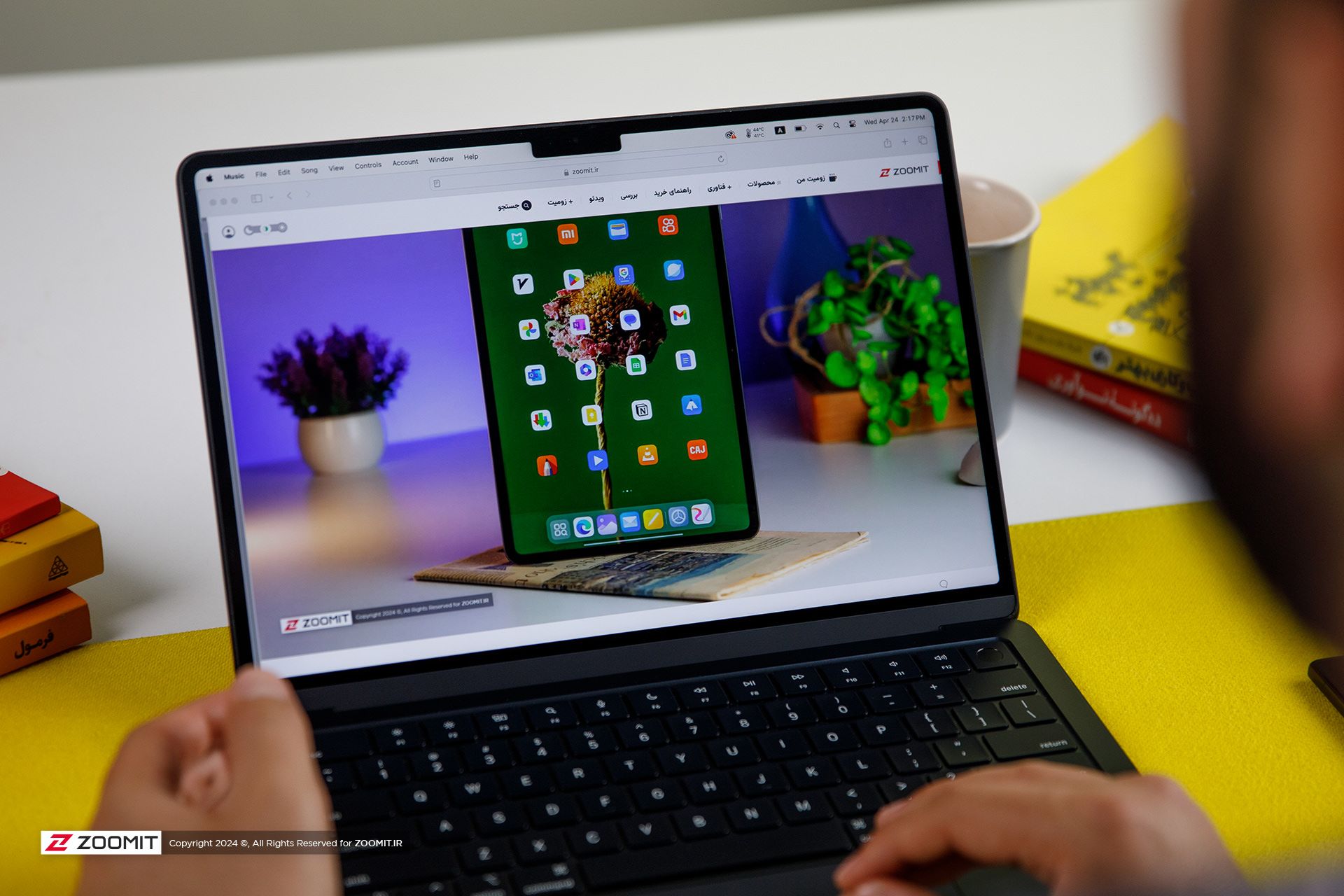
A person who already has a MacBook Air M2 and uses it for daily use should not go for the MacBook Air M3; Because it will not experience any significant changes; Except for the faster SSD, which is hardly noticeable in everyday use. For a current Mac M1 user, it might make more sense to upgrade to the M3.
For people who use laptops for tasks such as programming or video editing, the 8GB version of the MacBook Air M3 is not really a rational choice. If these people prefer macOS, it is better to go for used models with a budget of 70-75 million tomans, such as M1 Pro with 16 GB RAM, or if they are comfortable with Windows, high-quality options such as HP Envy with Core i9-13900H processor. And 16 GB of RAM will be a reasonable option for them.


How to connect to the TV with a Samsung phone?
It doesn’t matter if you have a Samsung TV or you are using a Sony TV or an Xvision TV, in this article we will teach you how to connect your Samsung phone to the TV so that you can view the contents of your phone on the TV.
-
Connecting Samsung phone to Samsung TV
-
Connecting a Samsung phone to a Samsung TV with Screen Mirroring technology
-
Connecting a Samsung phone to a Samsung TV with an HDMI converter
-
Connecting Samsung phone to Samsung TV with Samsung DeX
-
Connecting Samsung phone to Samsung TV with Wi-Fi Direct
-
Connecting Samsung phone to LG TV
-
Connecting Samsung phone to LG TV with Smart View
-
Connecting Samsung phone to LG TV through USB-C to HDMI converter
-
Connecting a Samsung phone to a Sony TV
-
Connecting a Samsung phone to a Sony TV through Screen Mirroring
-
Connecting a Samsung phone to a Sony TV with a cable
-
Connecting Samsung phone to Android TV
Connecting Samsung phone to Samsung TV
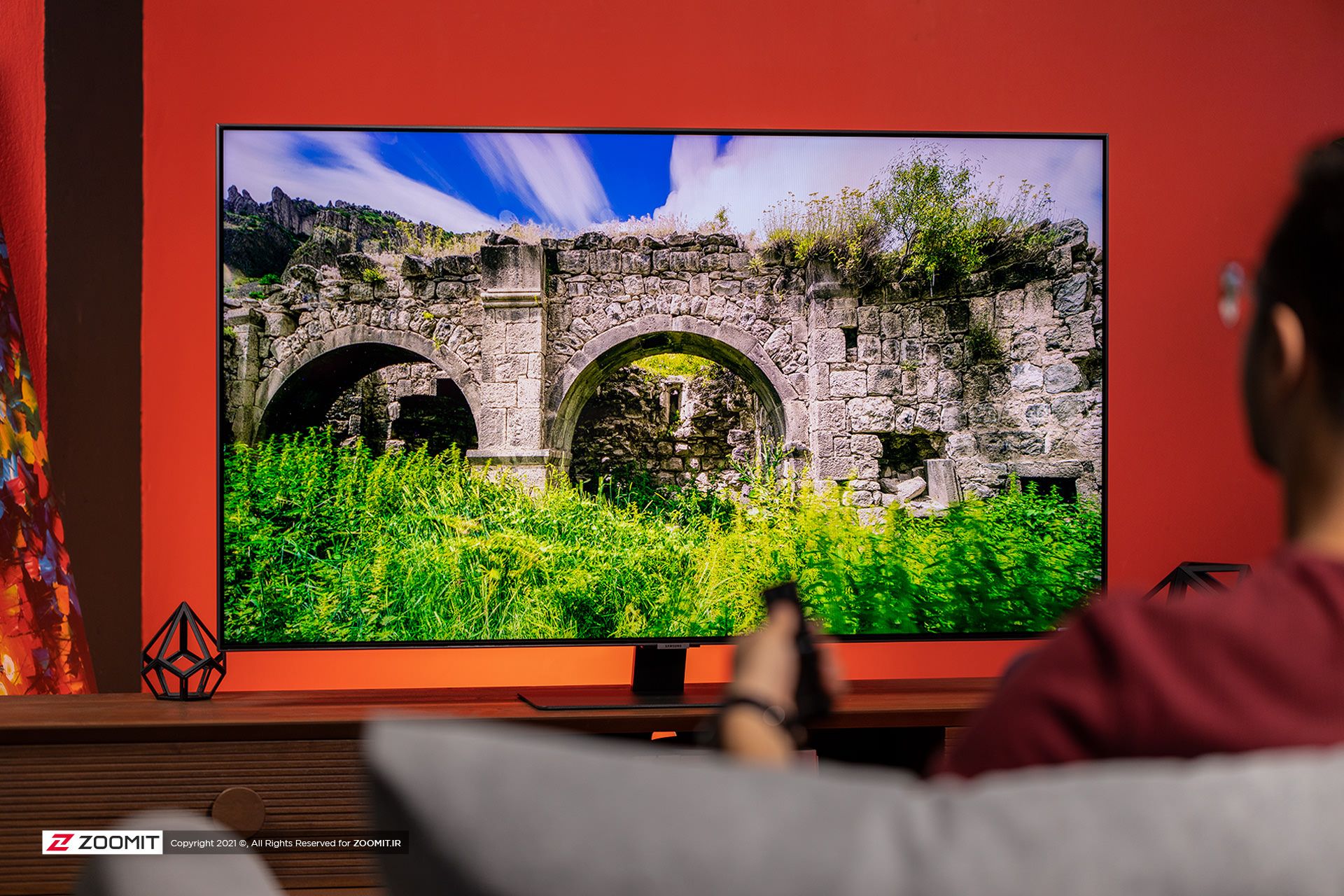
Connecting a Samsung phone to a Samsung TV with Screen Mirroring technology
Screen Mirroring is a technology that allows the screen of your phone to be transferred to the TV screen as it is so that you can view the content on the big screen. The SmartThings app and Smart View feature allow you to quickly and easily connect to your Samsung Smart TV.
To wirelessly connect your phone screen to your TV, your TV needs a Wi-Fi connection. For non-smart TVs, connecting via cable will be an easy and practical method that we will explain below.
Connecting Samsung phone to Samsung TV with Smart View
With the Smart View feature, you can view your phone’s screen wirelessly on a large TV screen. Follow the steps below to use Smart View on your Samsung phone:
- First of all, make sure your phone and TV are connected to a Wi-Fi network and VPN is not connected.
- Now on your phone, swipe down twice to open the Quick Settings panel and select Smart View.
- If you don’t see Smart View, please move it to the left or right or tap the edit button and then add Smart View.
- Select the desired TV to connect to the phone and then click Start Now.
- Finally, select Allow if displayed on the TV screen.

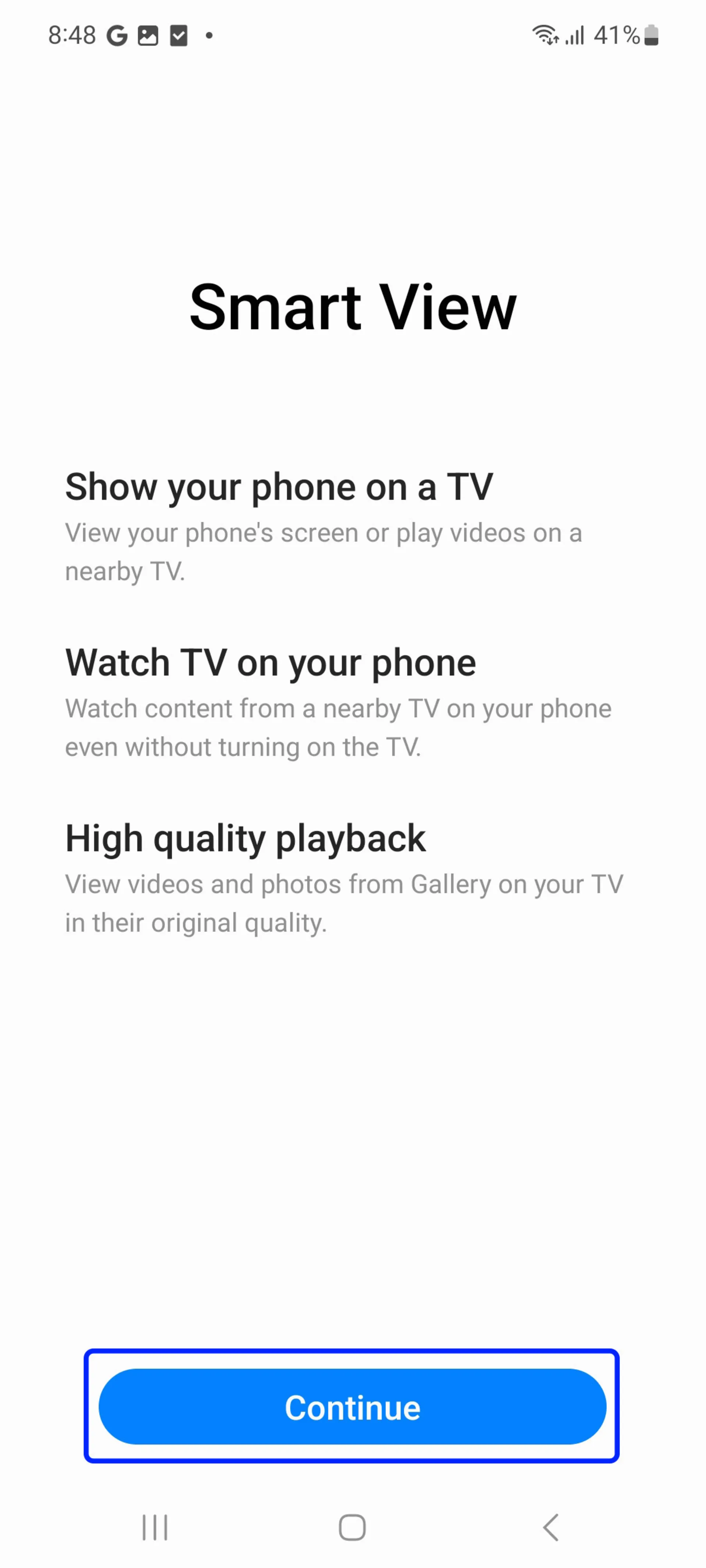


Note: If the TV refuses to connect to the phone, do the following steps to activate the connection:
- Go to Settings, and click on All Settings.
- Tap Connections and then External Device Manager.
- Select Device Connect Manager.
- Select the desired mobile device from the Device List and change the status to Allow.
To disable Smart View, disconnect from your phone or press the Return Button on the TV remote.
The device menus may be different depending on the model and software version. Please read the TV manual for more information.
Connecting Samsung phone to Samsung TV with SmartThings application
SmartThings is a remote control application for Samsung products that can be installed on Android phones and iPhone phones. SmartThings enables automatic connection to most Samsung TVs manufactured from 2016 onwards.
- Connect your Samsung Smart TV and Samsung phone to a Wi-Fi network.
- Download and install the SmartThings app on your phone. If you already have the SmartThings app installed, update it.
- Open the SmartThings app.
- Tap Add Device.
- All devices in SmartThings will be displayed. If you can’t see your device, make sure it’s turned on. If it still doesn’t show up, try turning it off and on again and restarting the SmartThings app.
- Select or scan your TV.
- Tap on the TV name and connect to your phone.
- Now your TV is connected to SmartThings and you can use your phone as a second remote control for your TV. You can also use Smart View to display photos, videos, and music from your phone.
- To do this, tap on the name of your connected TV at the top of the application and select More Options or the three-dot icon.
- Select Mirror Screens (Smart View). Make sure your phone is close to the TV to connect successfully.
Connecting a Samsung phone to a Samsung TV with an HDMI converter

If you have trouble connecting wirelessly, you can use an HDMI converter to connect your device to your TV. Original Samsung HDMI converters support devices with USB-C ports.
If you’re using an older device without a USB-C port, you may be able to find a compatible interface cable, but functionality cannot be guaranteed.
- Connect an HDMI cable to the HDMI converter.
- Connect the other end of the HDMI cable to the HDMI port of the TV.
- Connect the HDMI converter to the USB port of your phone.
- Turn on the TV and change the input to the HDMI port you are using.
Connecting Samsung phone to Samsung TV with Samsung DeX
- Swipe your phone down twice to open the quick settings menu. Note that this feature may not be available on some phones.
- Tap the DeX button to activate this feature.
- Select DeX on the TV or monitor option.
- Accept the connection request on the TV.
- Then follow the instructions on the screen. Once completed, the Samsung DeX screen will appear on the target TV.
Note that the function of this function will be different depending on the type of TV for wireless connection. We recommend using Samsung Smart TVs 2019 or newer.
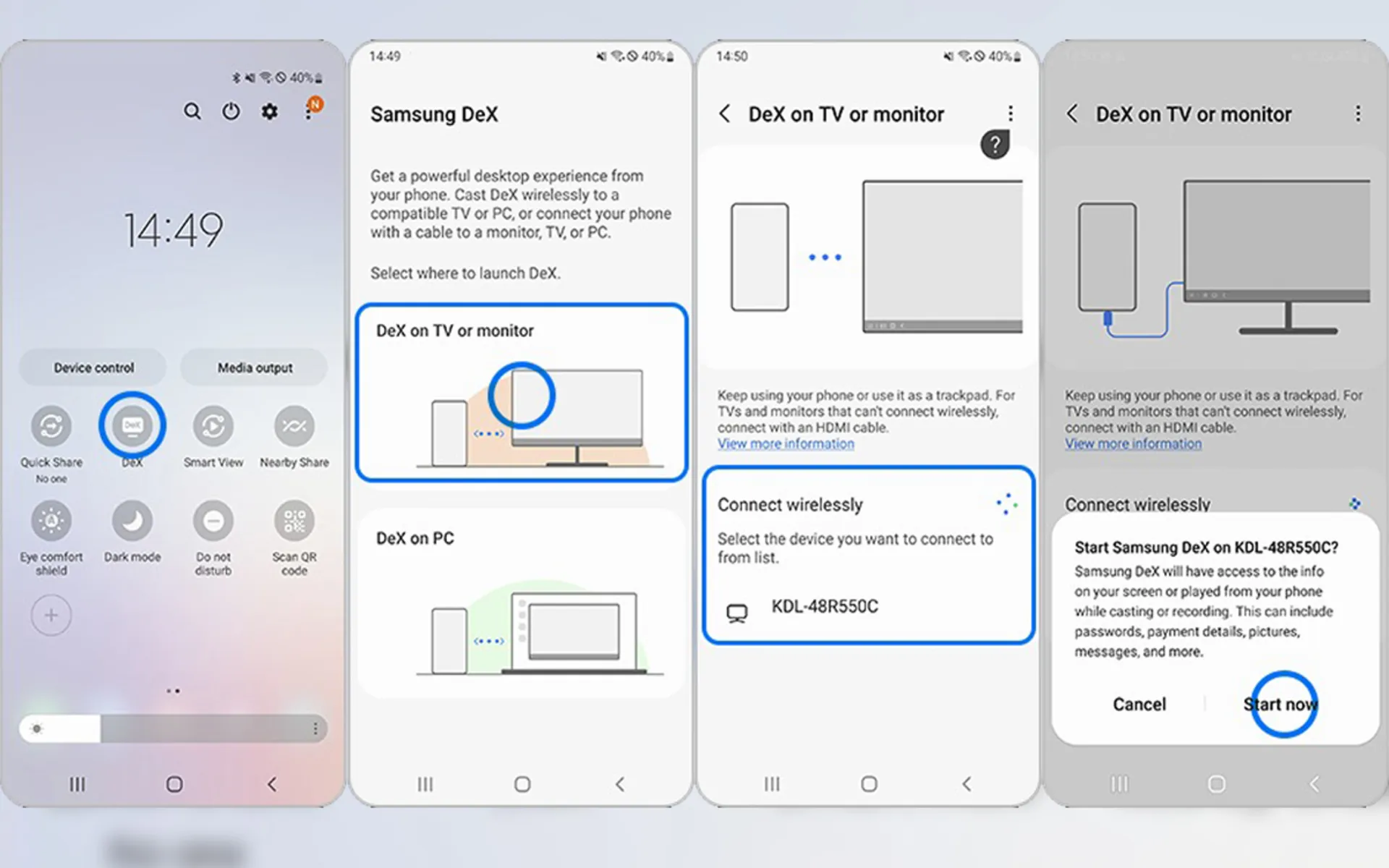
Connecting Samsung phone to Samsung TV with Wi-Fi Direct
With Wi-Fi Direct, you can directly connect your phone to the TV without an existing Wi-Fi network. With this, your favorite images and videos will be displayed on the TV screen. Note that both the TV and phone must have Wi-Fi direct capability for this feature to work.
To check whether the Wi-Fi direct feature is equipped on the TV, go to the settings. Now follow the steps below to use Wi-Fi Direct on Samsung TV:
- First, open the TV menu to enable Wi-Fi Direct. Then go to Network and Wi-Fi Direct.
- Now activate the phone’s Wi-Fi Direct. To enable Wi-Fi Direct on your Samsung phone, go to Settings, then Connections, enter the Wi-Fi section, tap the three-dot icon at the top, and enable the Wi-Fi Direct option. After scanning, the phone will display a list of available devices. The name of the phone also appears on the TV.
- Select the device from the list to start the connection. If a connection request is made by the phone, a message will appear on the TV and vice versa. Accept the request to connect the phone to the TV.
Connecting Samsung phone to LG TV
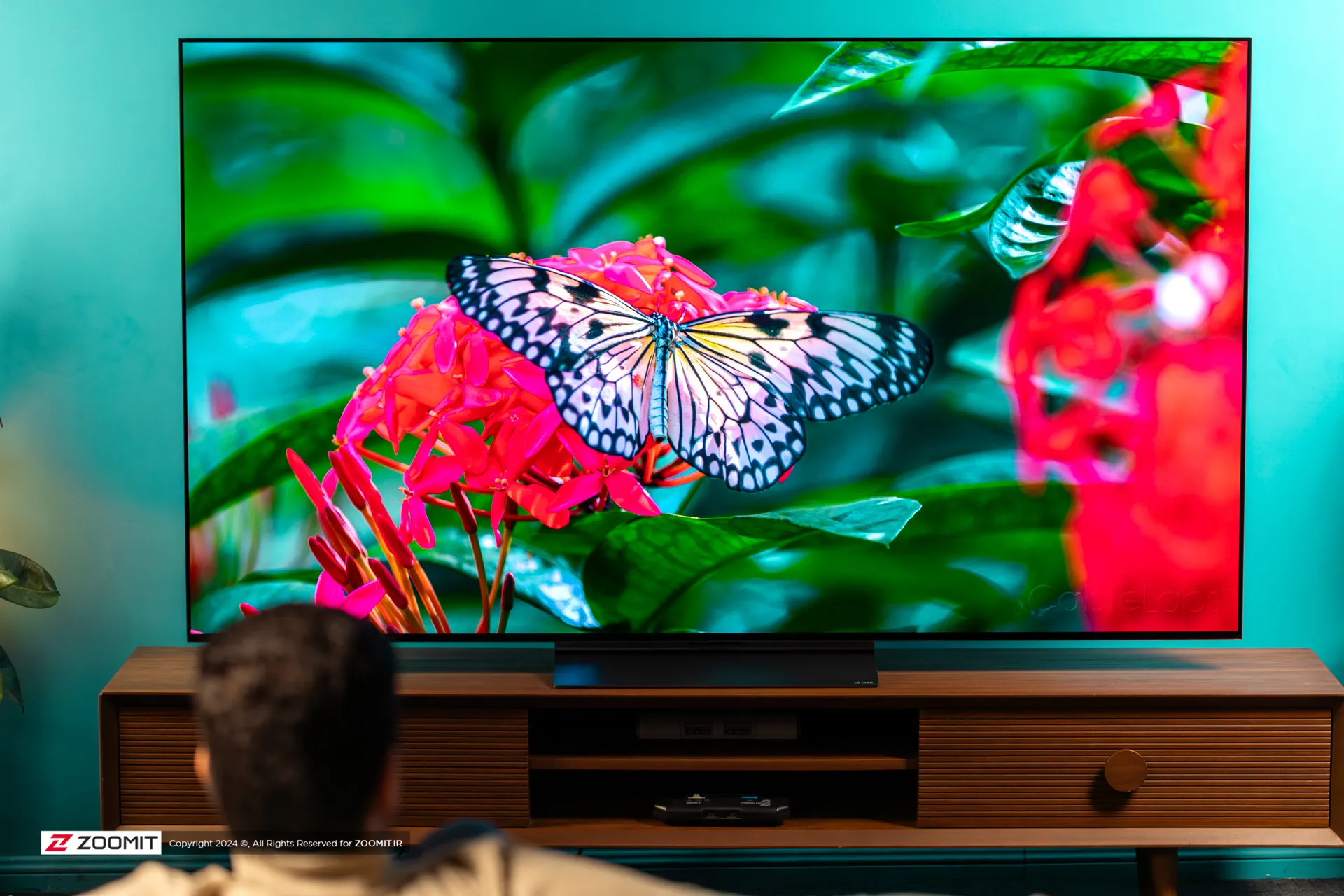
Connecting Samsung phone to LG TV with Smart View
You can also use the Smart View feature on LG TVs like Samsung TVs. Here is the step-by-step guide to enable this feature:
- Swipe down on your phone screen and select Smart View.
- Make sure your TV and phone are both connected to the same Wi-Fi network.
- Select your TV from the list of available devices.
- Thus, your phone screen should be reflected on the TV in a few moments.
Connecting Samsung phone to LG TV through USB-C to HDMI converter
You can connect your phone to the TV using a USB-C to HDMI converter. The steps are as follows:
- Connect the USB-C end of the adapter to your phone.
- Connect the HDMI end to the HDMI port on your TV.
- Tap “Accept” when the connection request appears on your phone
- After connecting, your phone screen will be mirrored on the TV screen.
This method is simple and hassle-free to use, especially when wireless options are not available.
Connecting a Samsung phone to a Sony TV
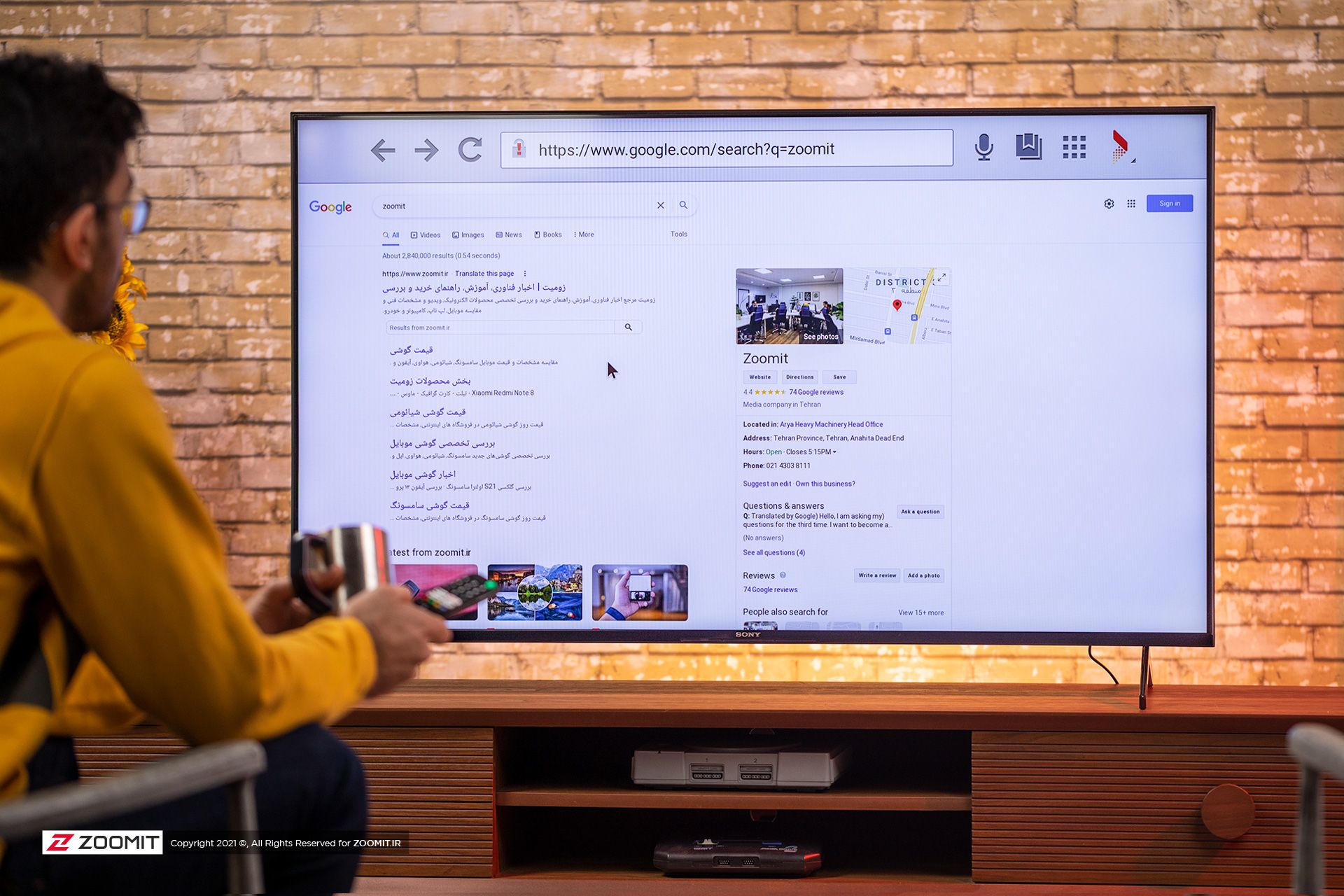
Connecting a Samsung phone to a Sony TV through Screen Mirroring
Fortunately, you can use the same Smart View feature of Samsung phones to connect to Sony TV. Thus, it becomes easy for you to seamlessly connect to any of the devices.
- Swipe down twice to reveal the Quick Panel.
- Select the Smart View icon.
- From there, you should see a list of devices compatible with the display. Click on your Sony TV.
- You should get a message asking if you are ready to connect. Select “Start Now”.
If your TV does not appear in the list of devices, you need to make sure that the TV is compatible. Note that only Sony Bravia TVs manufactured between 2013-2020 have Screen Mirroring capability.
Connecting a Samsung phone to a Sony TV with a cable
MHL technology provides the possibility of connecting the phone to the Sony TV with a cable. Phones and tablets compatible with this feature can be connected to the TV through an MHL to HDMI cable. If you can’t use wireless to connect your phone to the TV, then a wireless connection and HDMI conversion is another way you will have.
Connecting Samsung phone to Android TV
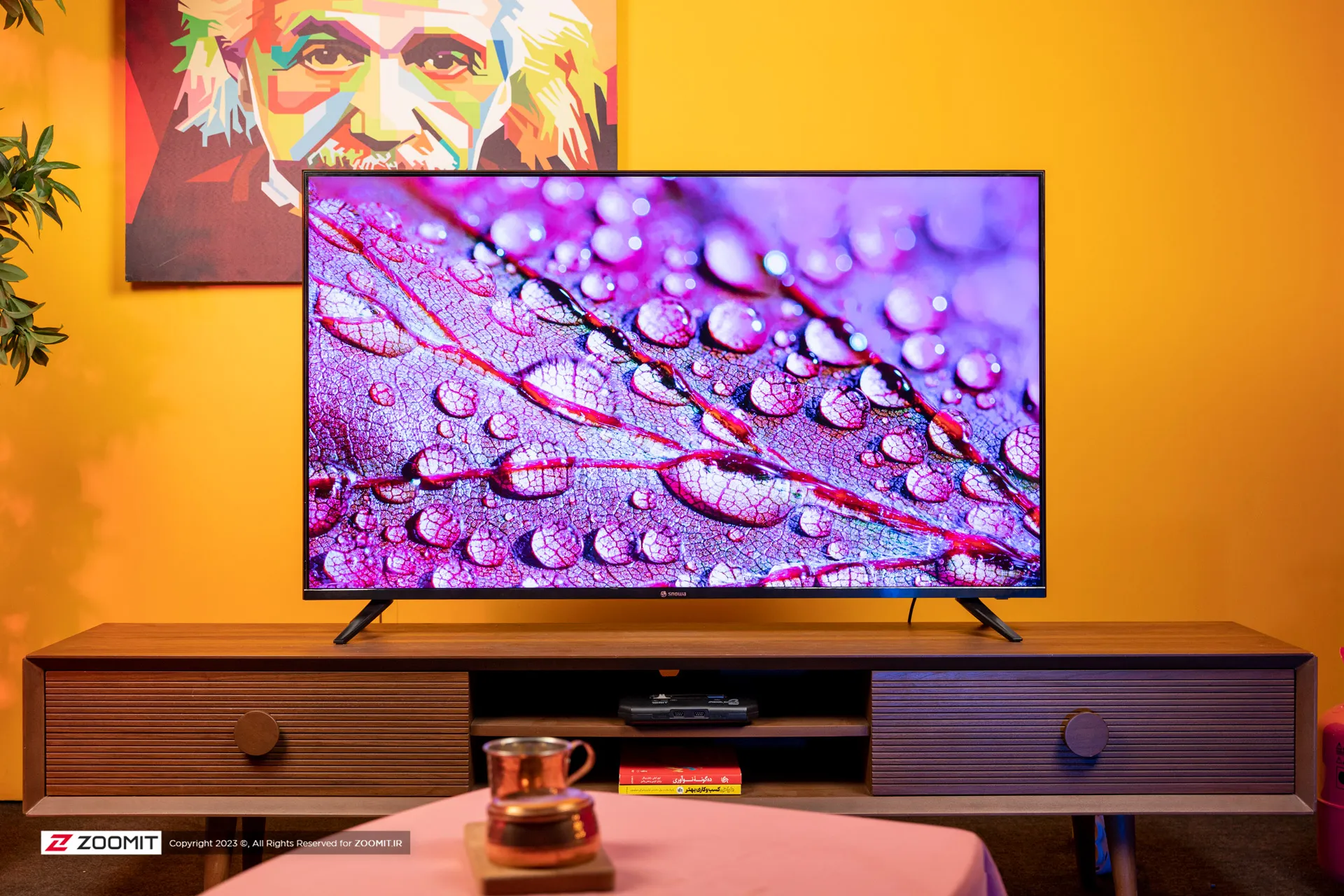
If you are looking for a wireless connection between your phone and TV, the Smart View feature on Samsung phones is the best way to share data on Android TVs, especially Iranian smart TVs. We have explained the activation method in the above sections.
On the other hand, if your TV is not smart, using cable will help you. As mentioned, you’ll need an HDMI cable and a USB-C to HDMI converter for this. Connect the USB-C end to your phone and then connect an HDMI cable between the converter and your TV. After connecting the converter and cable, the screen of your Samsung phone will appear on the TV.
Connecting a Samsung phone to a TV is not particularly complicated, especially when both devices are in the Android ecosystem. Earlier, we also checked the method of connecting the iPhone to Samsung TV; In addition, you can use the best programs to connect the iPhone to the TV so that more options are available to you.


The strangest things that can happen to humans in space
When it comes to space and astronautics, we all remember very interesting movies in which strange things happen to astronauts. Movies with exciting stories, most of which are nothing but the authors’ imaginations; But there are other very amazing stories happening in space that are completely real and have nothing to do with human imagination. In this article, we try to discuss some examples of these events and introduce you to the wonders of space travel.
Strange things that happen to humans in space
The human heart changes shape in space
It may seem a bit strange and even unbelievable that traveling to space can change the shape of the heart, But such a thing happens in reality and scientific studies have proven it. Less work of the heart and less pumping of blood leads to a decrease in the volume of the muscles of this organ, and this ultimately causes the hearts of astronauts to become more spherical by about 9.4%.
Despite the temporary nature of these conditions, some doctors believe that the reduction in the volume of the human heart during space travel may have serious consequences. According to NASA, researchers are researching this issue, and the results of this study will not only help astronauts but will also affect ordinary people and the inhabitants of the planet.
There is a possibility of mental problems in space
Living in the extraterrestrial atmosphere is associated with many problems. Changing living conditions and experiencing a completely different environment with very specific conditions imposes many psychological pressures on astronauts. These issues cause astronauts to experience special psychological conditions and are susceptible to various problems such as anxiety and depression.
Being away from family, lack of simple facilities such as sunlight or even fresh food, and heavy work are among the reasons that expose astronauts to various mental illnesses.
Human vision decreases in space
Visual impairment caused by intracranial pressure or VIIP is another space travel wonder faced by astronauts. This problem was observed for the first time in 2005 and in an astronaut named John Phillips. The Washington Post investigates this issue in an article and states that Phillips experienced a significant loss of vision after returning from his space trip. This incident prepared the groundwork for the researchers’ research for further investigations.
Additional research showed the changes in the appearance of the astronauts’ eyes and the loss of their vision after returning from space travel. Currently, the only possible reason that has been proposed for the occurrence of such conditions is the lack of gravity and the creating double pressure on the astronauts’ skulls; Of course, the research in this field continues and it is still not possible to say with certainty a specific reason for the occurrence of these conditions.
The body’s immune system weakens in space
Traveling to space, along with its excitement and surprises, also brings many problems for humans. One of these problems is the weakening of the body’s immune system in space, which was first discovered by astronauts during the Apollo mission. The story was that the astronauts in this mission experienced problems such as irregular heartbeat, dehydration, and inner ear disorder, and faced many problems after returning from the mission.
Studies conducted in this field have shown that after leaving the Earth’s atmosphere, the immune system of astronauts weakens, in part due to the abnormal activation of a type of immune cells called T-regulatory lymphocytes. This weakening is sometimes so severe that it causes astronauts to deal with latent viruses such as chicken pox in addition to simple infectious diseases such as colds after returning from space travel.
Astronauts can lose their fingernails
As you know, astronauts wear special clothes to carry out their missions in space, which includes astronaut gloves. These gloves are designed in such a way that they put a lot of pressure on the astronauts’ hands and nails; This will eventually lead to their nails falling off.
It is true that the fall of fingernails or their swelling is not a simple matter that can be easily passed over, But it seems that doing more research to design more suitable gloves can minimize the possibility of this problem and astronauts will not face such a problem in the future.
Human height grows taller in space
Another wonder of space travel, which makes it one of the favorite trips of ordinary people, is the increase in height that occurs during this trip. As soon as you leave the Earth’s atmosphere, the gravity is close to zero, and this causes the pressure on the spine to decrease significantly. The reduction of this pressure, in turn, causes the height of the astronauts to grow a few centimeters.
One of the studies that confirms the truth of this issue is the research that NASA scientists conducted on two twin brothers. In this study, one of the twins had a 342-day trip to space and the other brother was examined on Earth. The results of this and other research determined that the height of astronauts increases by 2 to 5 cm on average after space travel.
 Mark Kelly (left) and Scott Kelly (right) made it possible for researchers to study the health effects of long-duration space travel by studying NASA twins.
Mark Kelly (left) and Scott Kelly (right) made it possible for researchers to study the health effects of long-duration space travel by studying NASA twins.
Traveling to space leads to weakening of muscles
Another strange thing that happens to astronauts in space and affects their health is the weakening of muscles or atrophy. Long space travel causes muscle wasting in astronauts, so they are trained to exercise continuously during their journey.
NASA is working on this issue to find solutions to prevent the problem of muscle wasting. The reason for the importance of this issue is the need for astronauts to have strong muscles and a healthy body so that they can perform their difficult missions in space in the best possible way.
Space swells astronauts’ faces
A large volume of our body is made up of liquid. On Earth, gravity pulls this fluid down and collects some of it in the lower limbs; But in space, where microgravity prevails, our body fluids are more evenly distributed; As a result, astronauts’ faces look puffier than normal, and on the other hand, their legs appear thinner than when they are on Earth.
According to the Washington Post, “the phenomenon of puffy-faced bird’s legs” appears when blood and other body fluids accumulate on the side of the upper body due to low gravity and stay there; As a result, the heads swell and the legs shrink. In this situation, the appearance of the astronauts can change by swelling their faces. Astronauts may experience excessive blood pooling; As if their head is constantly cold. However, after a few weeks in space, your body will adjust to the change in gravity and some of the facial puff will fall asleep.
Space travel may increase the risk of cancer
Astronauts who spend 6 months in space are exposed to almost as much radiation as a thousand chest X-rays. Exposure to different types of radiation exposes the body to the risk of cancer, damage to the central nervous system, bone loss, and some cardiovascular diseases. However, it has been difficult to accurately calculate the level of risk so far. Also, scientists’ information about the impact of radiation in long-duration space missions to deep space destinations such as the Moon and Mars is still limited.
The more time a person spends in space, the more radiation they are exposed to and, theoretically, the more DNA damage they accumulate. It is not possible to say with certainty whether this DNA damage actually increases the risk of cancer; Because cancer is affected by many environmental and genetic factors. For example, it’s probably fair to say that today’s astronauts are probably some of the fittest people on the planet. They probably eat a healthy diet, exercise a lot, and don’t smoke or drink much alcohol. All these things reduce the possibility of getting cancer.
Strange events for astronauts during space travel have always been one of the most fascinating topics for ordinary people. The wonders of space travel are not limited to the things we have mentioned, and at the same time as science advances and the scope of research increases, we will definitely see more interesting news in this field in the near future.


Skin cancer: symptoms, prevention and treatment


The strange ways skin affects our health


A mystery that is solved by the China’s Chang’e-6 probe!


Artificial intelligence identifies cancer killer cells


Discovery of new hydrothermal wells at a depth of 2.5 km in the ocean


The secret of the cleanest air on earth has been discovered


Xiaomi Pad 6S Pro review


Why do people listen to sad songs?


The biography of Pavel Durov


Why artificial intelligence has not yet succeeded in replacing Google?
Popular
-



 Technology9 months ago
Technology9 months agoWho has checked our Whatsapp profile viewed my Whatsapp August 2023
-



 Technology10 months ago
Technology10 months agoHow to use ChatGPT on Android and iOS
-



 Technology9 months ago
Technology9 months agoSecond WhatsApp , how to install and download dual WhatsApp August 2023
-



 Technology11 months ago
Technology11 months agoThe best Android tablets 2023, buying guide
-



 AI1 year ago
AI1 year agoUber replaces human drivers with robots
-



 Humans1 year ago
Humans1 year agoCell Rover analyzes the inside of cells without destroying them
-



 Technology10 months ago
Technology10 months agoThe best photography cameras 2023, buying guide and price
-



 Technology11 months ago
Technology11 months agoHow to prevent automatic download of applications on Samsung phones

